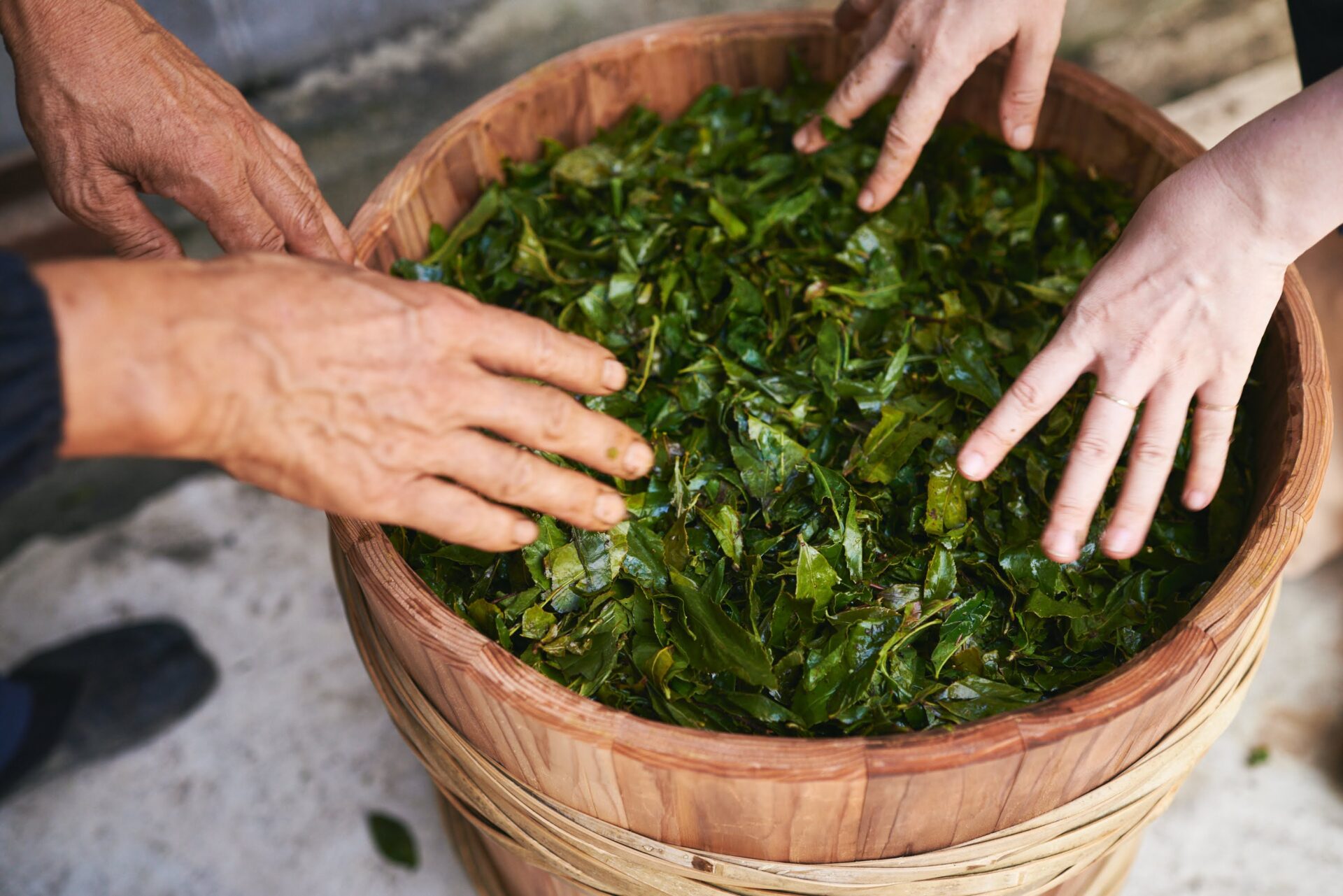“Make your own Awabancha tea?”
It all started when we came across the introduction of the Barrel Owner Program on the Kamikatsu Awabancha Tea Association community Facebook page.
Kamikatsu Town in Tokushima Prefecture has the smallest population in Shikoku, with just 1,500 residents. DIG THE TEA visited this town in 2021 and introduced the Kamikatsu Awabancha Tea, which is a very rare lacto-fermented tea that is only made in Kamikatsu Town.
(Related Article: The Secrets of Lacto-Fermented Tea, and How a Japanese Town Grabbed the World’s Attention)
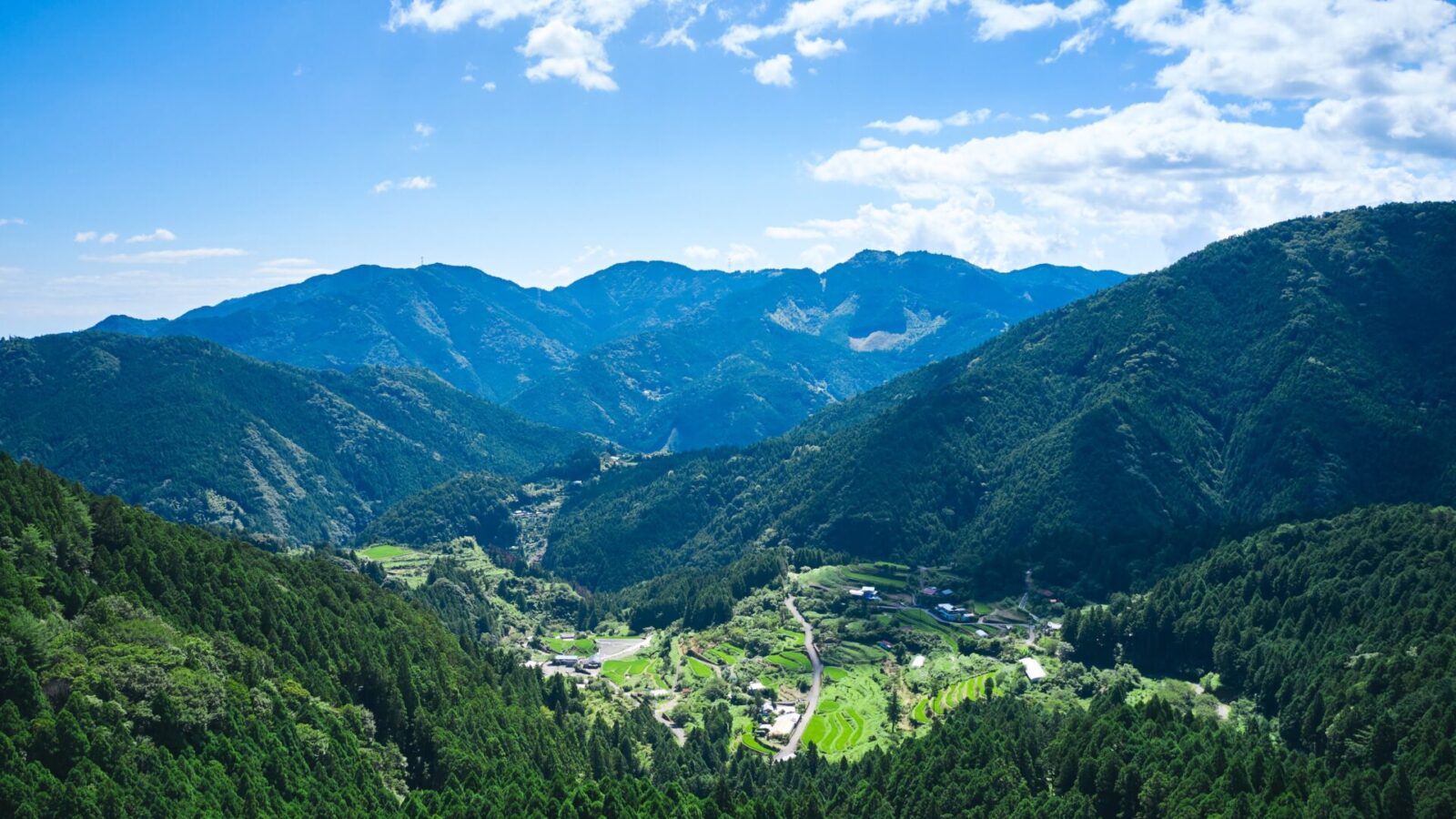
Because the flavor is greatly influenced by bacteria unique to the area and climate, Awabancha tea differs in flavor with each farmer, just like wine. The process of production is almost entirely done by hand, and the more you learn about it, the more fascinating Awabancha tea becomes.
On the other hand, while Awabancha tea is becoming a popular and highly sought after tea around the world, it also faces serious challenges as the number of producers decrease each year due to a lack of successors, and may someday disappear altogether.
Our team fell in love with Awabancha Tea and had to take action.

Our team concluded that if we learned more about Awabancha tea, perhaps we could find a way to help preserve it.
As part of the “DIG THE TEA Experiments” series, we decided to participate in the Kamikatsu Awabancha Barrel Owner Program, hosted by the Kamikatsu Awabancha Tea Association. This program allows people to become the owner of a 50 liter barrel of Awabancha Tea.
We sought to learn the actual processes of making Awabancha tea and conduct further experiments with the Awabancha tea we made ourselves.
Our imagination and hope had been sparked so we put it to action.
This article will introduce the first step of our experiment; the making of Awabancha tea.
Become a Barrel Owner and make your own Awabancha Tea
The Kamikatsu Awabancha Barrel Owner Program is a new initiative that just started in 2021.
The process of making Awabancha tea starts with storing boiled tea leaves in a wooden barrel and soaking them to instigate the lactic acid fermentation. By participating in this program and process, one can become the owner of that Awabancha tea barrel.
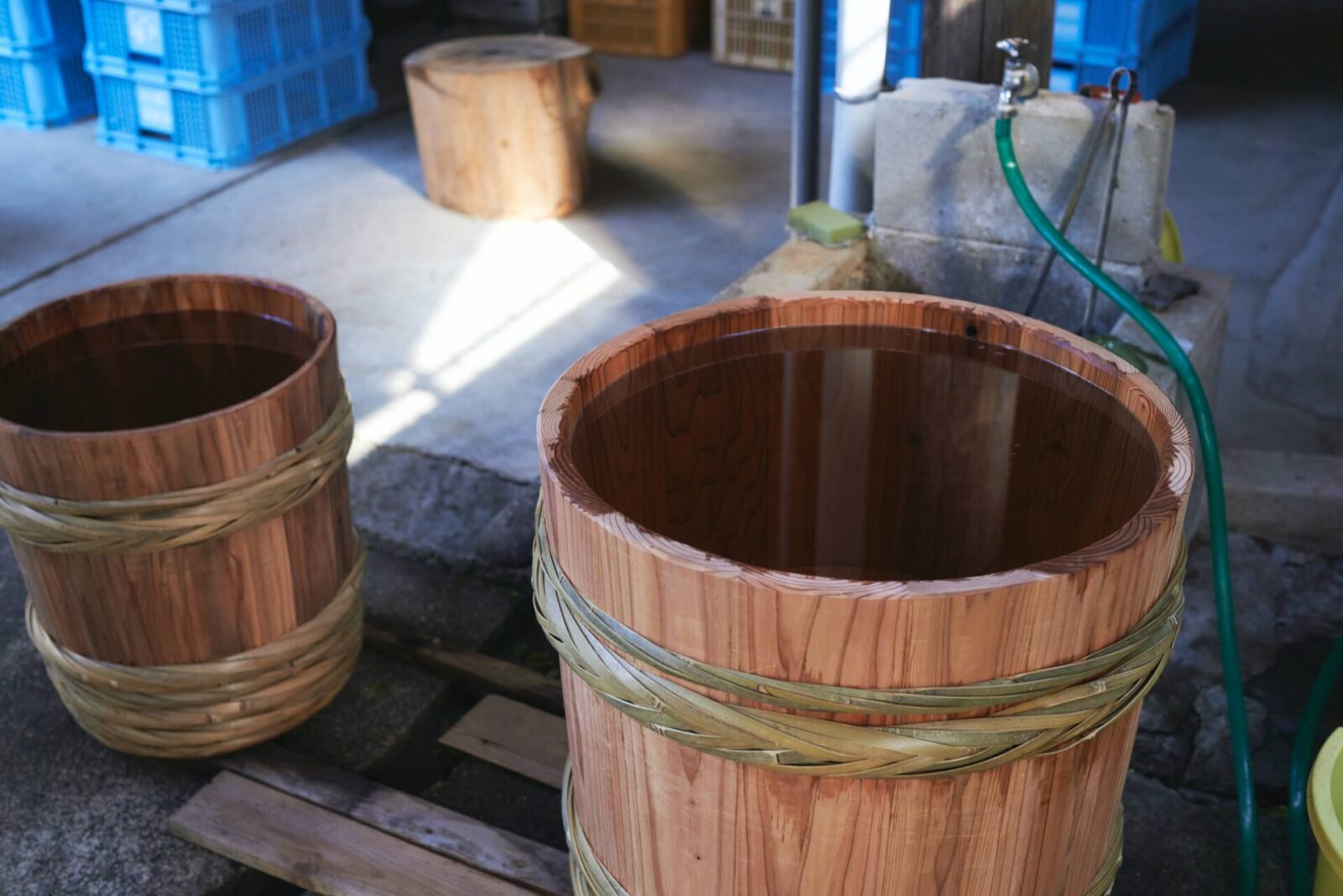
A unique feature of the program is that one can experience the traditional process of making the tea under the guidance of a professional. Additionally, if the owners wanted to eventually sell the tea that they produced, the Kamikatsu Awabancha Tea Association would help them do so.
DIG THE TEA would love to have our readers try out the Awabancha Tea that we made.
This means that we cannot fail in making a good quality tea. With a determination to succeed and deliver a delicious tea, we took on the challenge of becoming a barrel owner.
Before we begin, let’s review the steps to making Awabancha tea. The process can be simply divided into eight steps.
- Harvesting
- Sorting
- Boiling
- Rubbing
- Soaking and fermenting
- Remove from barrel
- Drying in the sun
- Sorting and packaging
On this trip, we will experience the processes from steps one to five.
Awabancha Tea is harvested from July to August in the height of summer when the tea leaves are fully grown. The matured leaves are said to have more nutrients than fresh sprouts and it helps promote the fermentation process.
We headed to Kamikatsu Town in mid-July in the peak heat of the summer season.
People had previously told us that “making Awabancha tea is hard work” and “it is five times harder than what you imagine.” One of the reasons may be because it is done under the intense heat of summer.
The DIG THE TEA team landed in Tokushima Awaodori Airport, rented a car and drove an hour and a half to Kamikatsu Town. We arrived the day before the program, full of anticipation and some anxiety for what was ahead of us.
8 a.m. – Awabancha tea making commences
The day of our Awabancha tea making experience was a hot, summer-like day with the sun shining bright from early morning.
At 8 a.m., we drove up the narrow mountain roads and arrived at an old private farm house, which was the headquarters of the Kamikatsu Awabancha Tea Association.
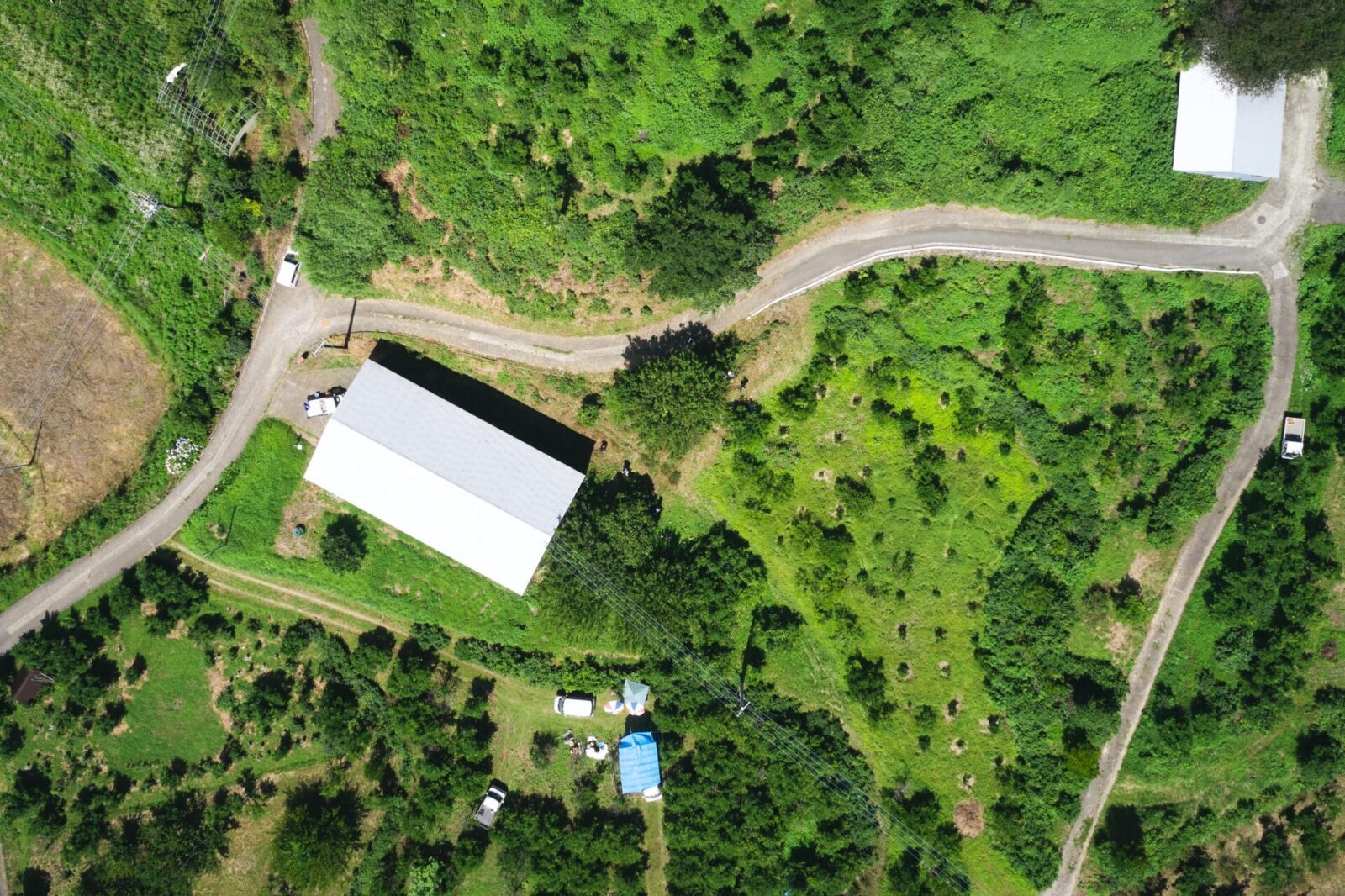
We were immediately greeted by Hiroshige Takagi, the head of the association, who would be teaching us how to make Awabancha Tea. We were also joined by Yumi Mima, another Awabancha Tea farmer, and other staff members who came from Osaka to help out for the day.
Our “DIG THE TEA Experiments” team consisted of 5 people. With the help of the members of the association, we set to work on making a 50 liter barrel of Awabancha Tea.
Stripping, not picking, tea leaves
The first task was to pick 30 kilograms of tea leaves. We started a little past 8 a.m.
Among all the tasks, this is the most labor intensive as it requires multiple participants. Some farmers finish this task in two to three days, while other farmers spend a whole month on it.
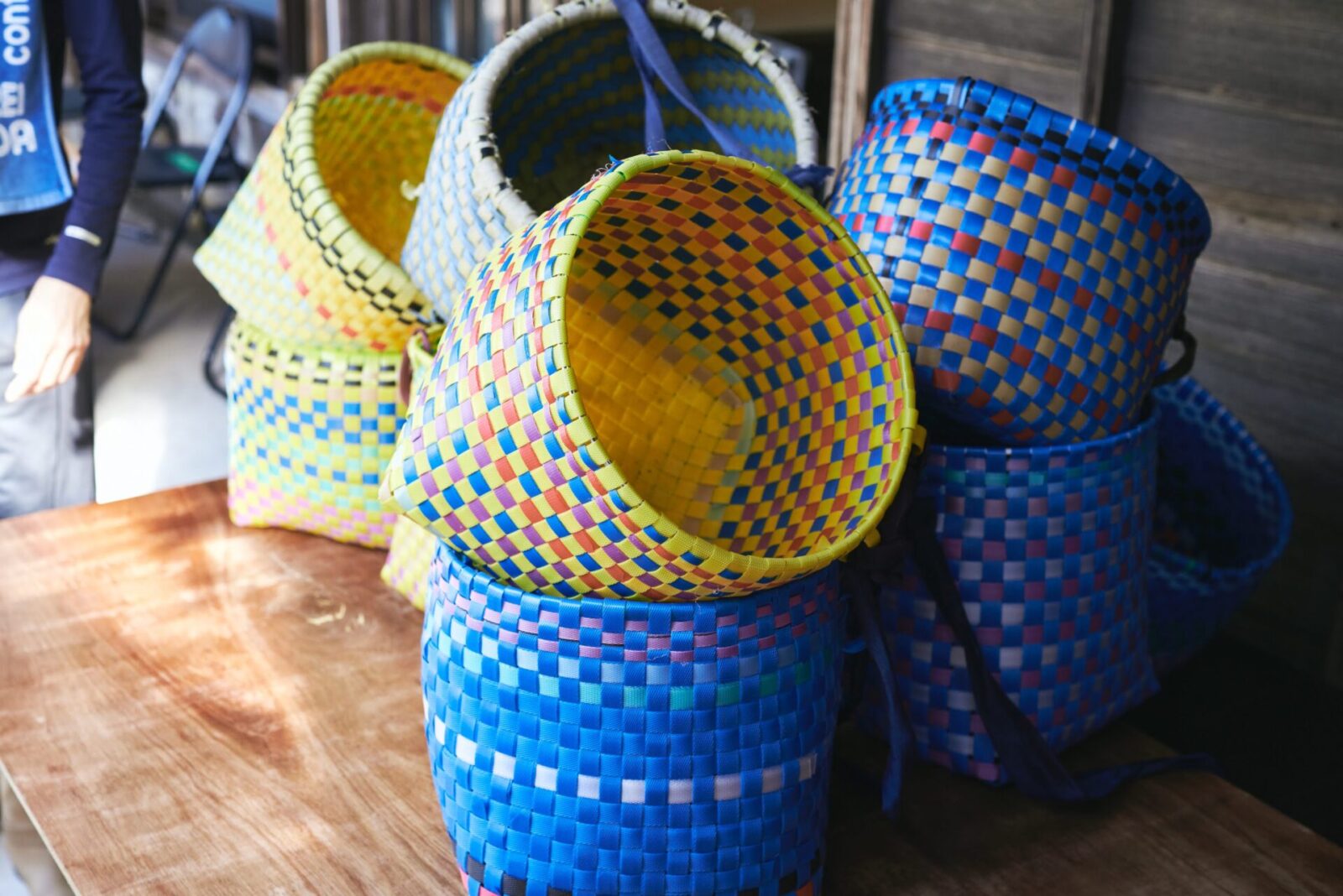
The association has been working hard to find pickers from both in and out of town. One factor that would help the continuation of Awabancha Tea in the future would be if they could find a steady and increased number of pickers.
“Unless we pick the leaves, we cannot make tea.” Takagi’s words were earnest indeed.
The tea plantation was about a ten-minute drive up the mountain from the farm house.
This tea plantation was not like what one would generally imagine a tea plantation to look like. There were wild looking tea trees growing on a steep slope next to a row of citrus trees.
Just standing and keeping balance on the steep slope near the tree was difficult in itself.
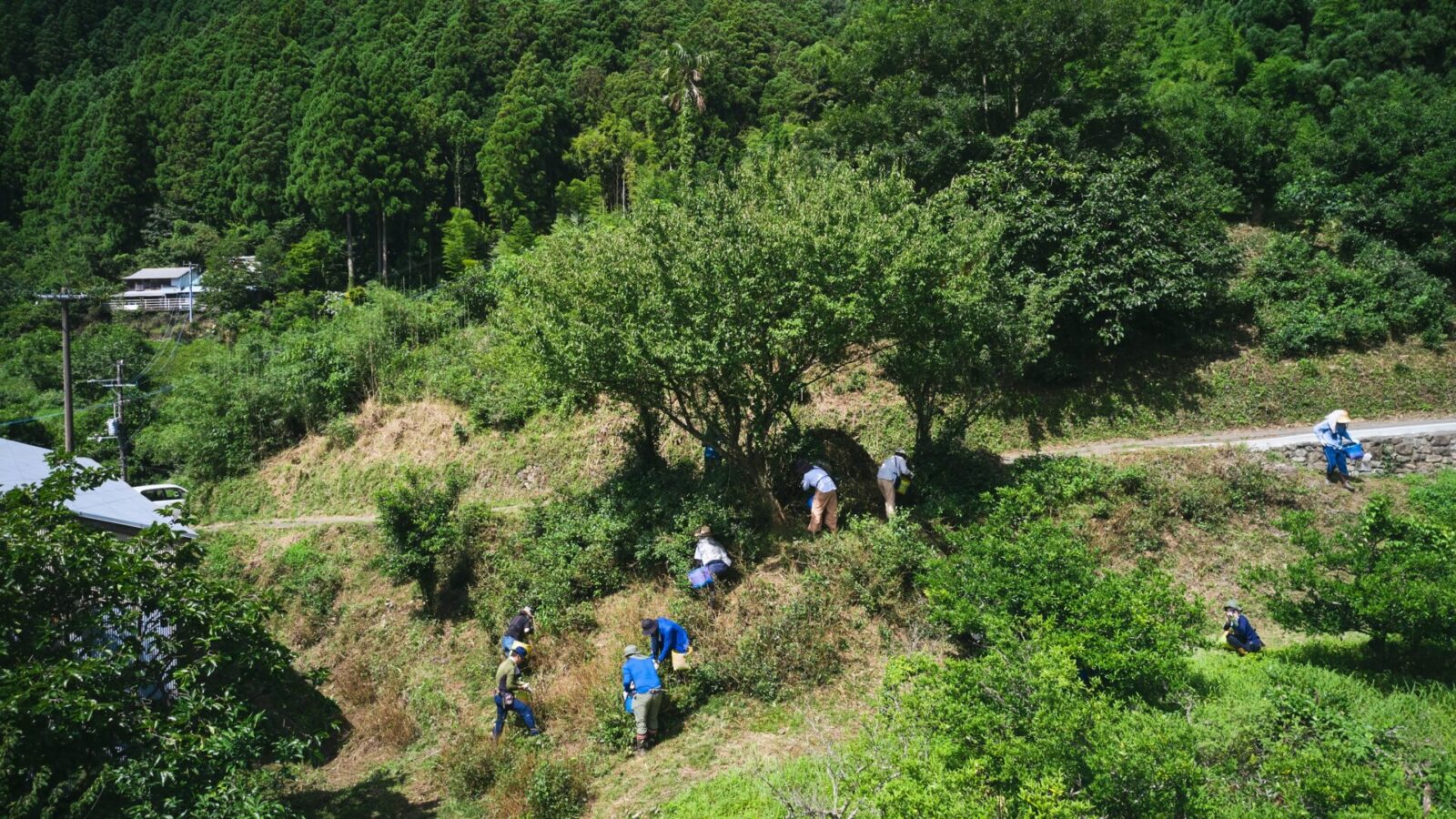
The Awabancha tea tree is grown organically so it does not use pesticides or fertilizer.
Takagi shares, “Although we don’t do anything in particular, there is a poultry farm nearby and the bacteria that is carried by the wind from it may have some positive effect on the tree growth.”
The tea leaves that are left over after drinking Awabancha tea are buried in fields and farms elsewhere and act as a fertilizer. Kamikatsu is known as a “zero-waste town,” and in an effort to eliminate wasteful consumption and garbage, everything is recycled and nothing goes to waste.
Awabancha tea uses the whole tea leaf, including everything from the matured leaves to the soft tips. It is said that the mixture of the various leaves give the tea a richer flavor.
The method of picking the tea leaves is also unique. From the overgrown tea tree branches, the picker chooses one branch. Gripping the branch with the palm of their hand, they pull off all the leaves from the base of the branch and up.
Even if dead leaves and the tea tree fruit gets mixed in the basket, they pull off everything from the top to bottom of the branch and put it in their basket. There is simply not enough time to pick the leaves individually.
The mature leaves are moderately hard so it takes a lot of strength to strip the branches clean of leaves.
The method is very different from what one would imagine as “picking” leaves.
It is more like “stripping” the leaves, so we should call it “tea stripping.”
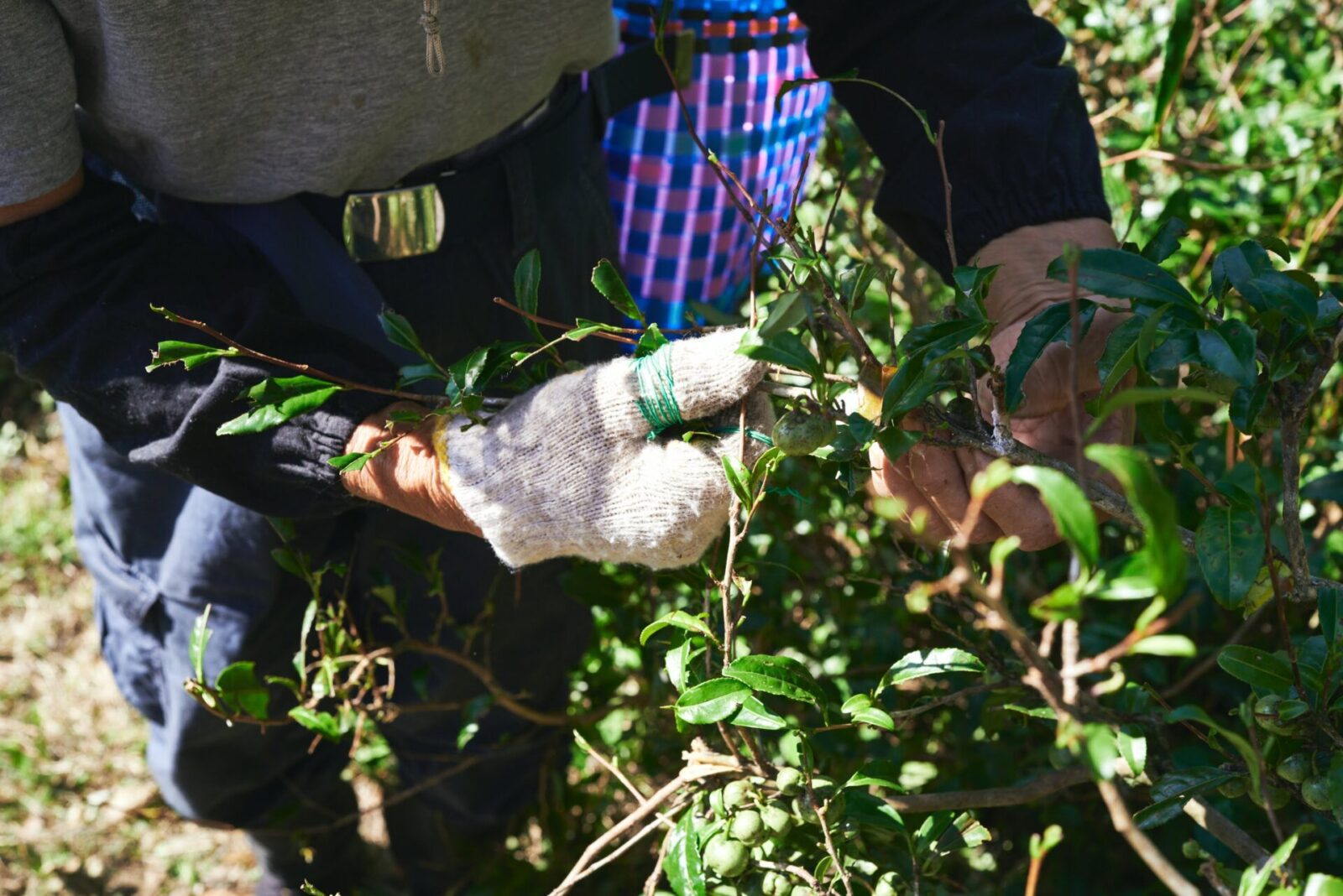
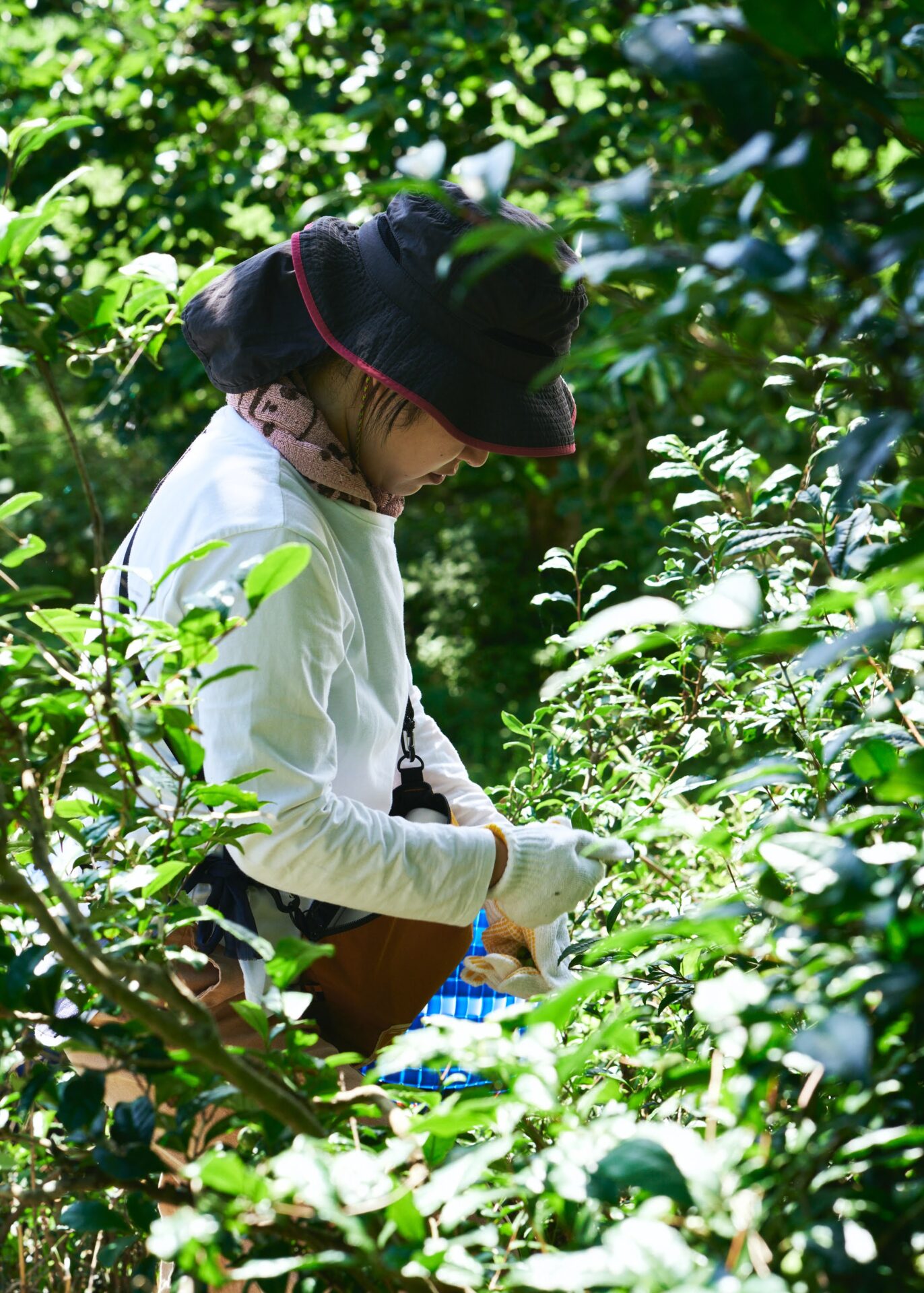
We asked Takagi for any tips on how to do this process and he simply answered, “Practice makes perfect.”
Heeding his advice, we continued to strip the tea leaves off the branches in silence under the midsummer heat.
For better or worse, it was a sunny day when we picked, but the regulars say that tea picking is done even in the rain. Another staff member told us “It’s actually nicer when it rains a little bit.”
After two hours of stripping away, we took a break at 10 a.m. and were handed a bottle of cold brewed Awabancha Tea.

The tea has a beautiful golden color, and with one sip the unique rich flavor that is unlike green tea or roasted tea, travels through the throat and hydrates the body.
Of course, working hard in the sun was one factor, but our team was once again impressed at how delicious the Awabancha tea was.
After the break, we resumed the work on harvesting the leaves until noon, which was the scheduled time to end picking.
Our hearts pounded in anticipation as we put the netted bag filled with our harvest on the scale.
The total weight came out to be 27.2 kilograms.
We were just short of our goal of 30 kilograms! Although we were so close to our goal, it was not enough. Takagi Farm provided the remainder of the leaves, but our team members all felt the agony of defeat.
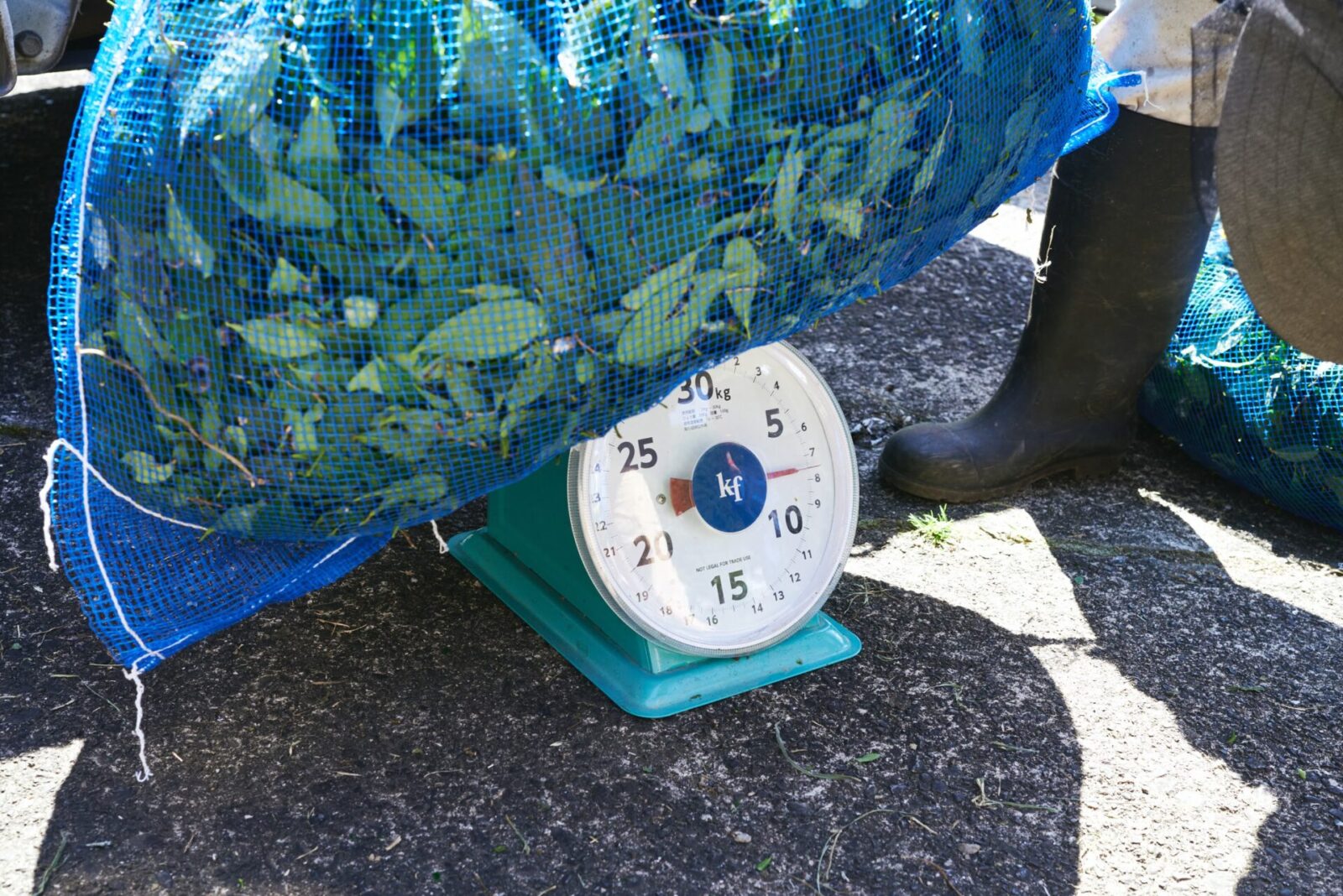

Now that we had finished the process of “tea stripping,” we took a lunch break to regain our strength. A bento box made with plenty of love and care by a local store was just what we needed.
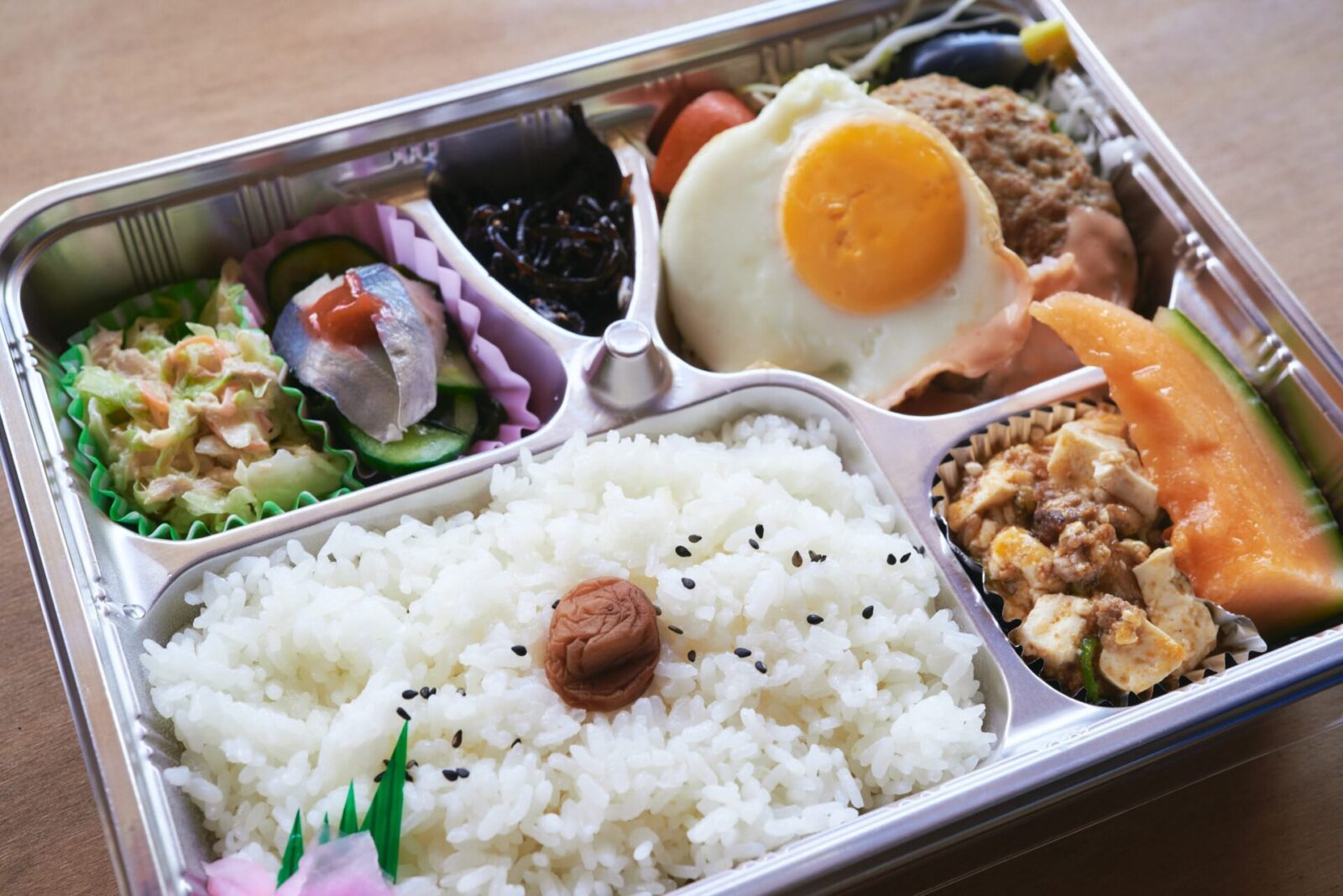
Breaking our backs for the finest tea
After lunch, the team members took turns in participating in the next steps of the Awabancha tea making process, which includes sorting, boiling, rubbing, soaking and fermenting the tea leaves. The boiling, rubbing, soaking and fermenting processes are collectively called “chasuri,” or “tea rubbing.”
Step 2 Sorting
First, we proceeded with sorting the harvested leaves. Dry leaves and tea tree fruits can cause the tea to become bitter if mixed into the final product so these are removed by hand.
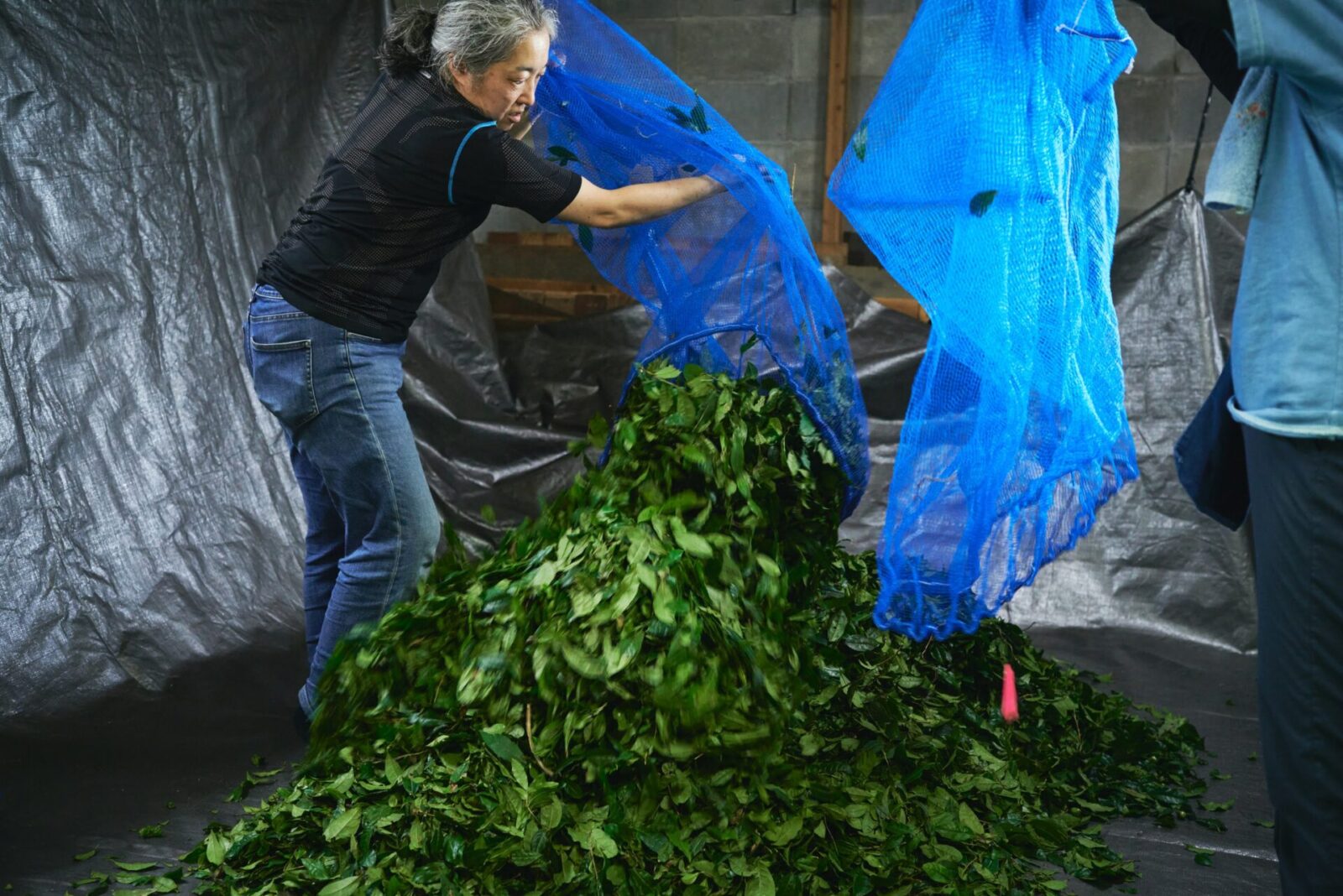
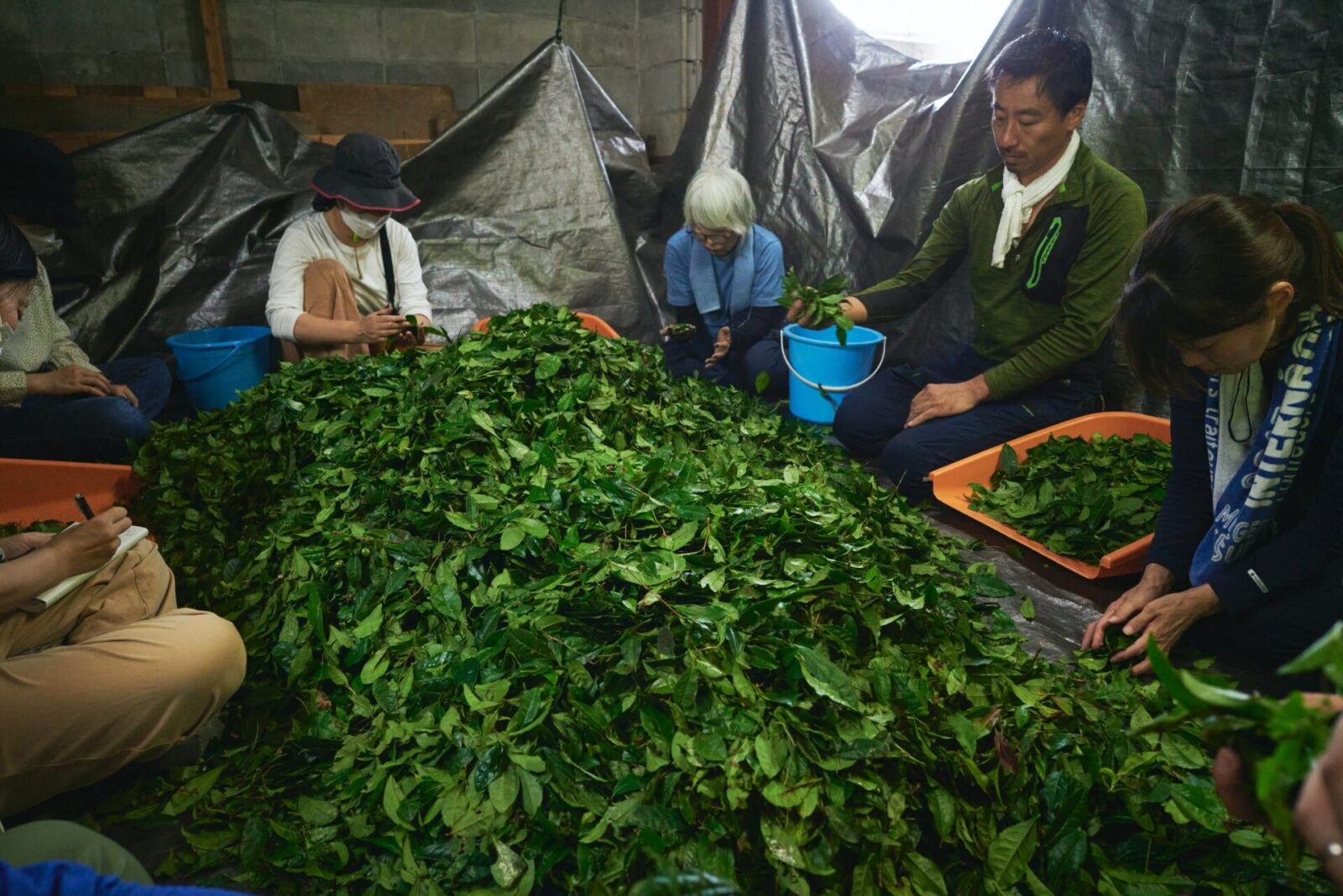
We were taken aback by the sight of 30 kilograms of tea leaves spread out on top of a plastic mat.
As we sat around the huge pile of tea leaves, we sorted the usable leaves and put them into bamboo baskets. When the baskets are full, the leaves are taken to the boiling process.
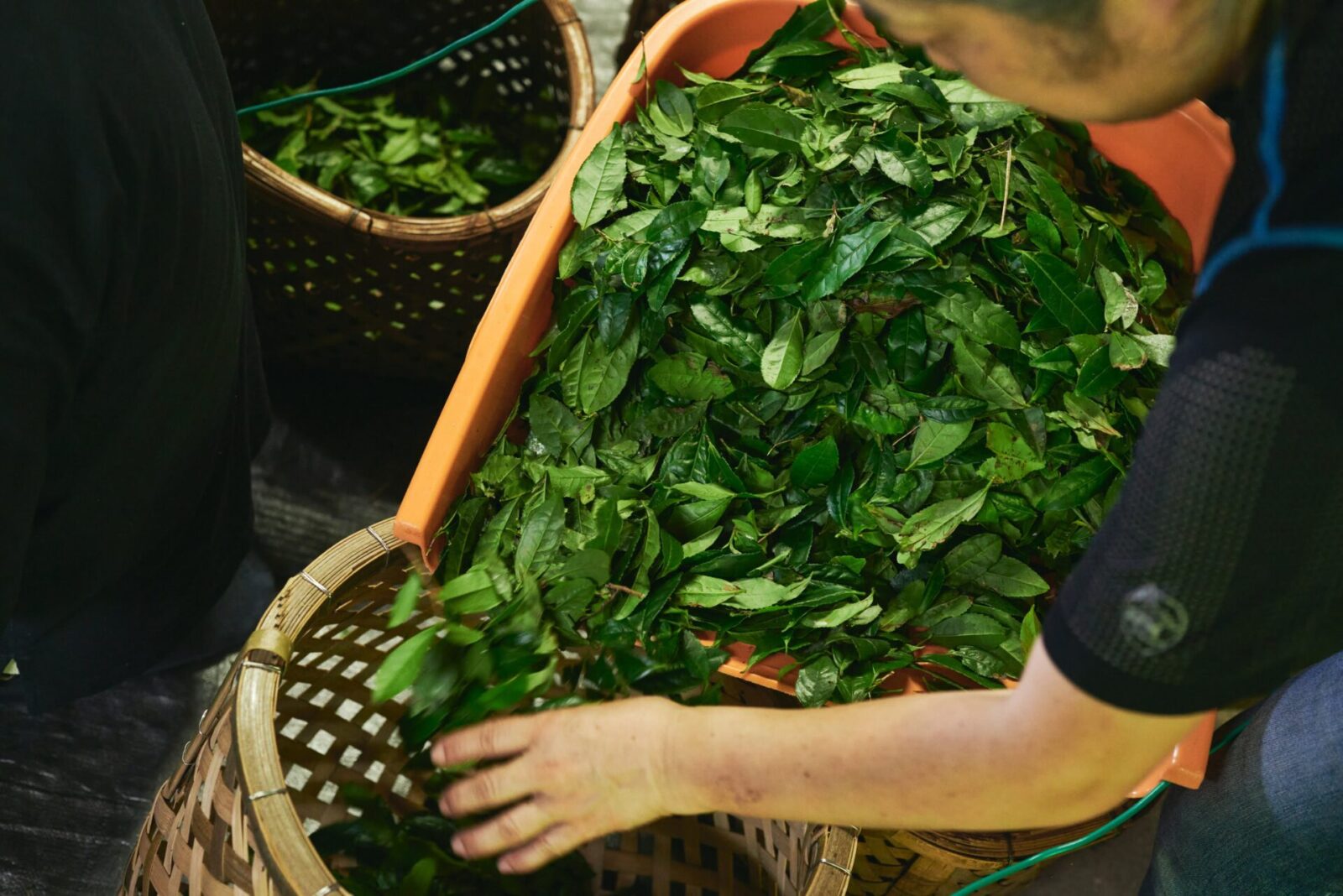
Step 3: Boiling
The bamboo baskets filled with tea leaves are directly inserted in a large pot of boiling water that is heated on a wooden fire.
The water used for boiling was collected from a nearby stream and the water is not replaced for the whole process of making Awabancha tea. The boiled water itself becomes like a secret sauce, so to speak.
This was the fifth day since the members of the association had started making Awabancha tea, so the water had turned into a brown murky tea color. It had a strong scent of the fresh green leaves. This “chajiru (tea soup)” is filled with tea leaf extract and it will be used in the soaking and fermenting process and plays an important role in the making of Awabancha tea.
The boiling process is done in pairs. One person puts the basket of tea leaves in the pot and the other person uses a big wooden flat spoon-like stick to swirl the leaves up and down in the water.
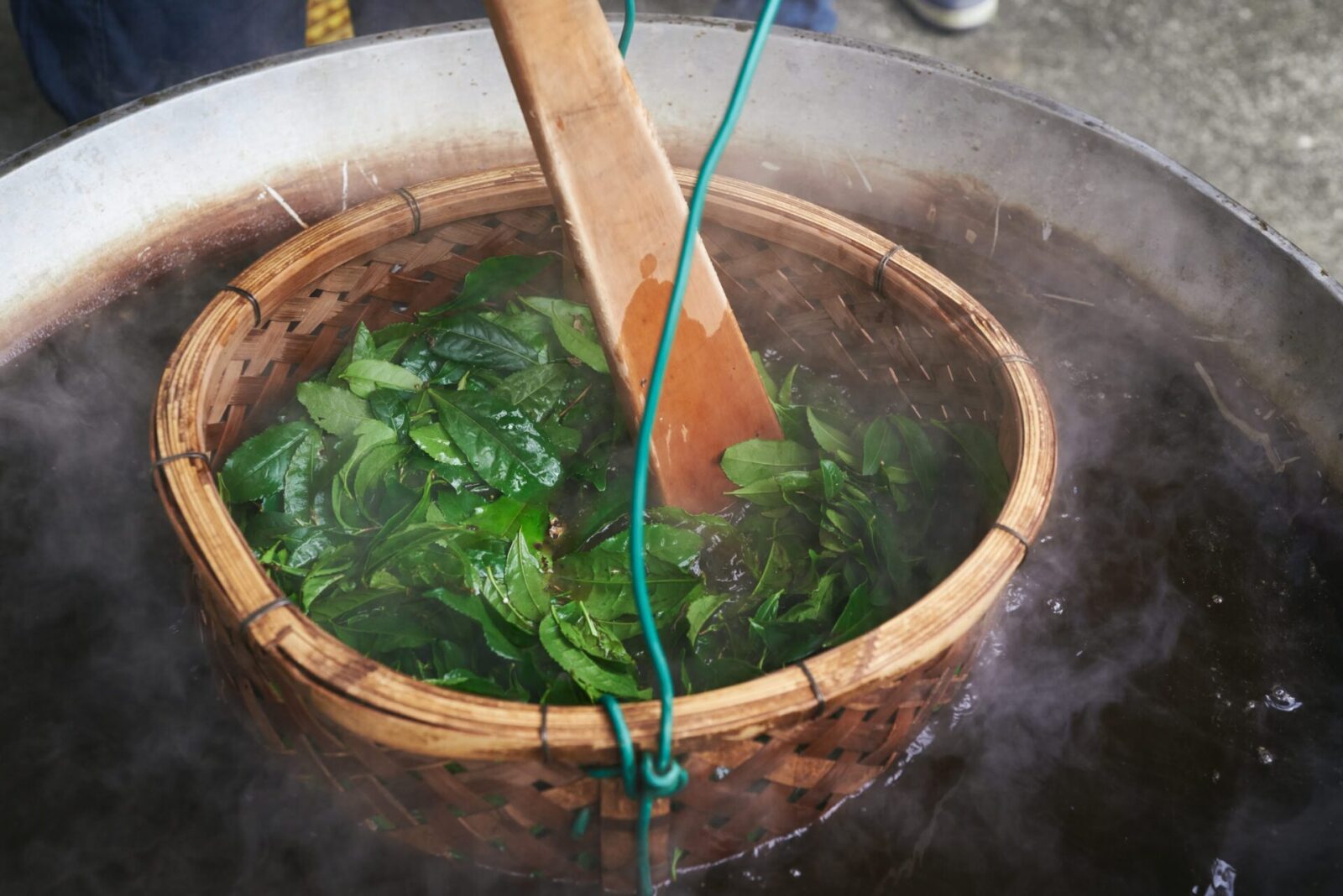
According to Mima’s method, the boiling time is three minutes. He says that changing the boiling time by just 30 seconds will change the final flavor. It is also Mima’s method to use a wood burning fire rather than a gas stove.
Mima laughs as he says, “To be honest, I don’t really know why we make it this way, but my grandmother taught me like this so I follow her methods.”
The flavor of Awabancha tea is slightly different depending on who makes it and that is part of its appeal. Each household has their own method and everyone respects that difference while passing it on to the next generations.
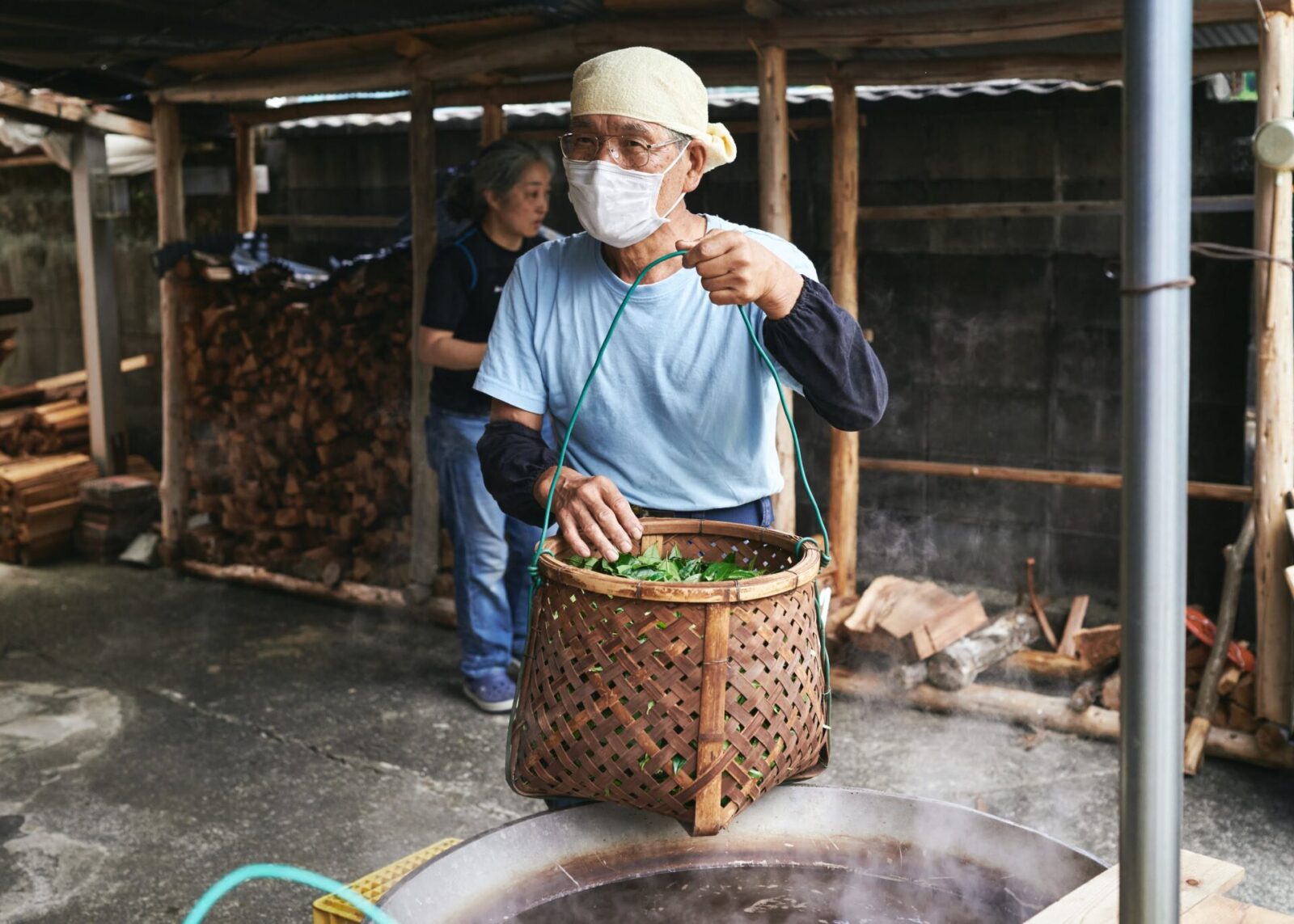
Of course, this boiling process is done in the heat of summer. With the added heat of the fire, it is harsh work.
Nonetheless, once things start moving, one cannot stop. There is still a huge pile of leaves waiting to be boiled.
We continued the process for about 20 baskets worth of tea leaves.
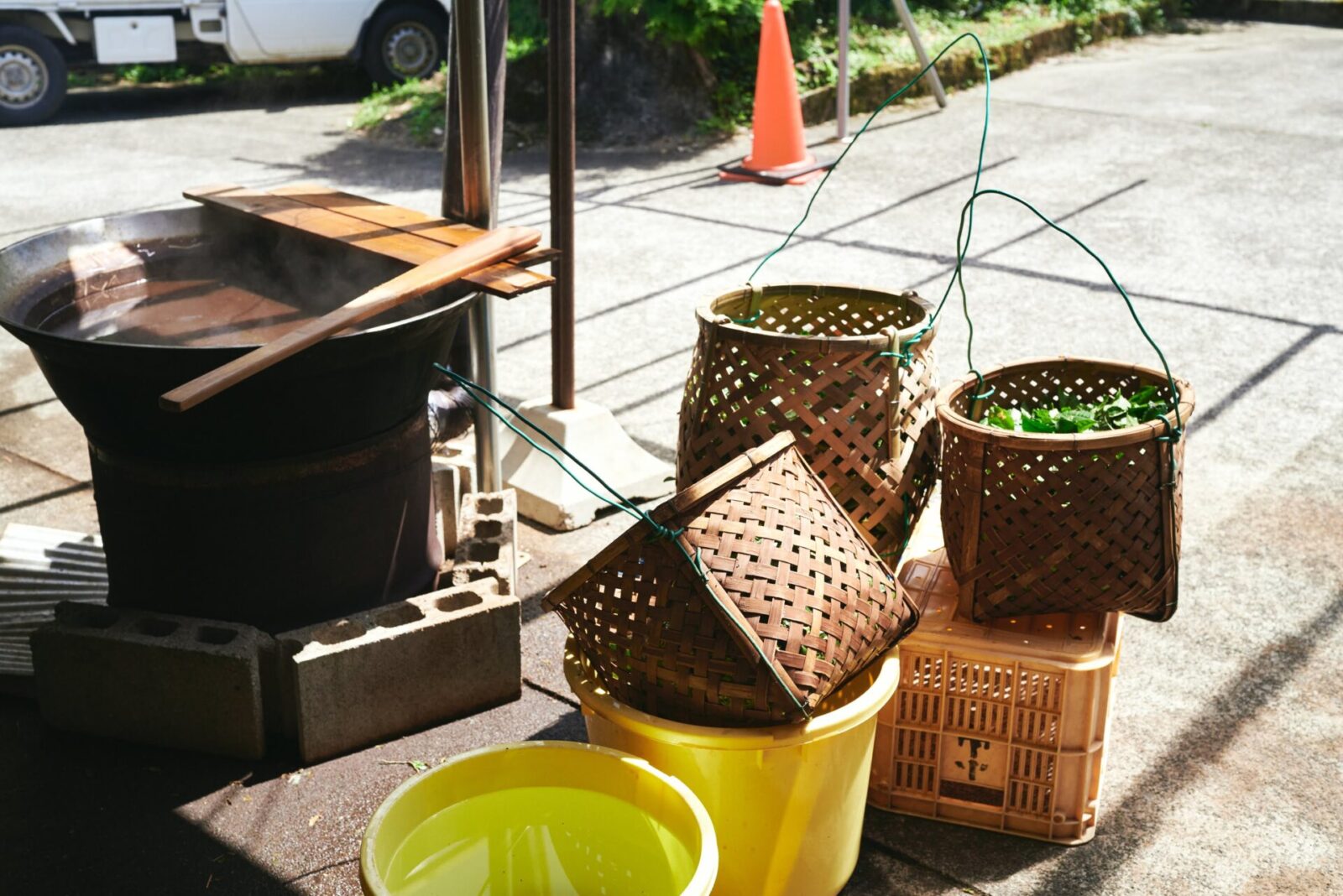
Step 4: Boiling
After the leaves are boiled and have turned a soft green color, they are rubbed together while they are still hot.
The process of rubbing is done to create cuts in the leaves to help instigate fermentation.
In recent years, many Awabancha farmers use a machine called a “junenki (rolling machine),” but in our program, we used a traditional tool called a “fune,” which means “boat.”
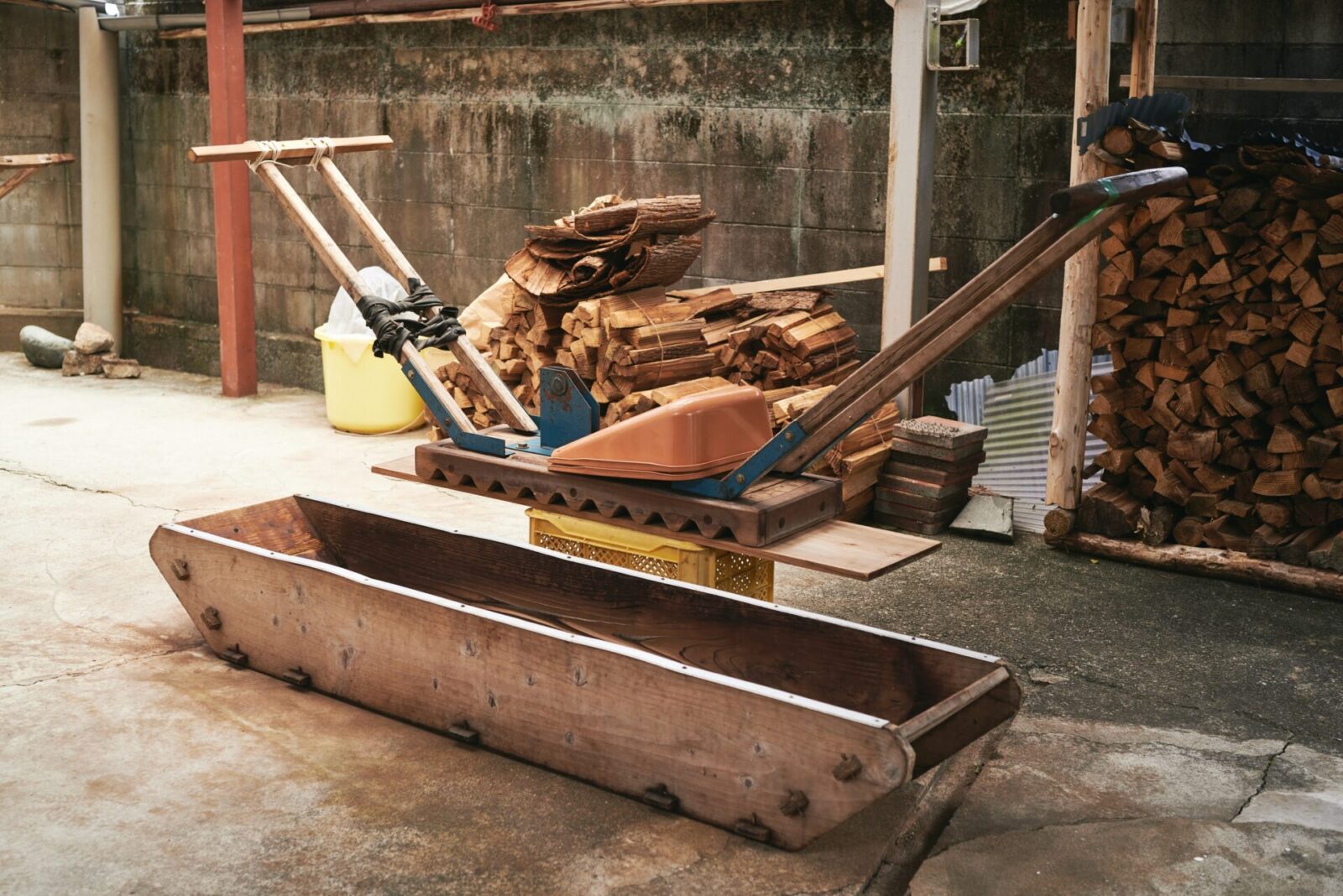
As the name implies, the tool is shaped like a boat and it is separated into upper and lower parts.
The boiled leaves are put into the bottom part and the heavy upper part that has handles on both sides is put on top. Next, two people work in unison to move the upper part back and forth.
The upper part has pipes lined with trachycarpus leaves to make a jagged bottom which rubs against the tea leaves to give it just enough cuts.
Soon we found out just how physically demanding this process is.
Each basket of boiled leaves is rubbed 200 times back and forth on this tool. This process is repeated for all 20 baskets.

The upper part that is moved back and forth is very heavy, and even with the strength of grown men, we needed to take many breaks.
“Rather than pulling, give it a little lift.”
“It gets lighter towards the end.”
“Your rhythm is improving! Keep it up!”
Miwa and Takagi cheer us on as they give us advice, and our minds go numb as we continue the endless process of rubbing the leaves.
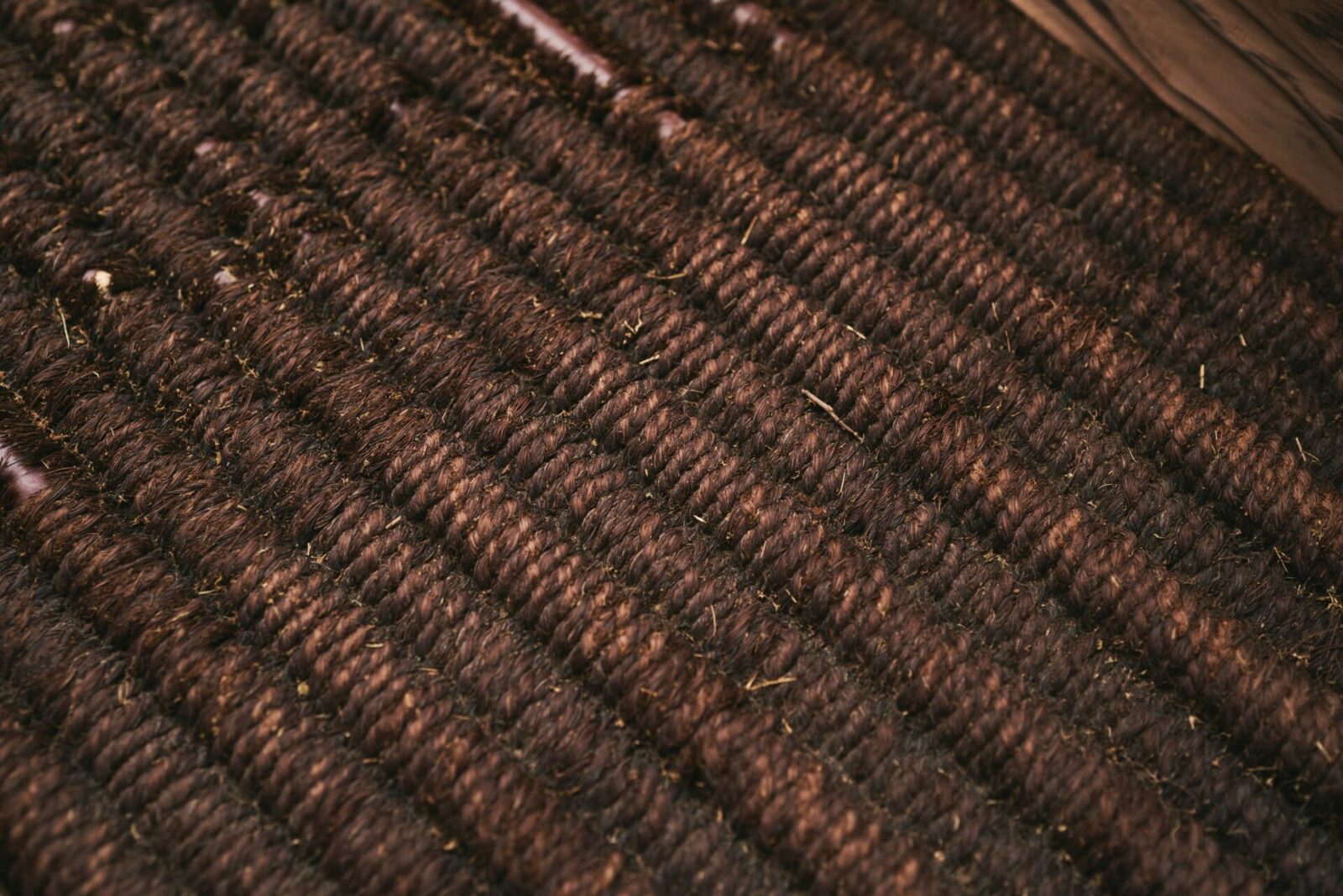
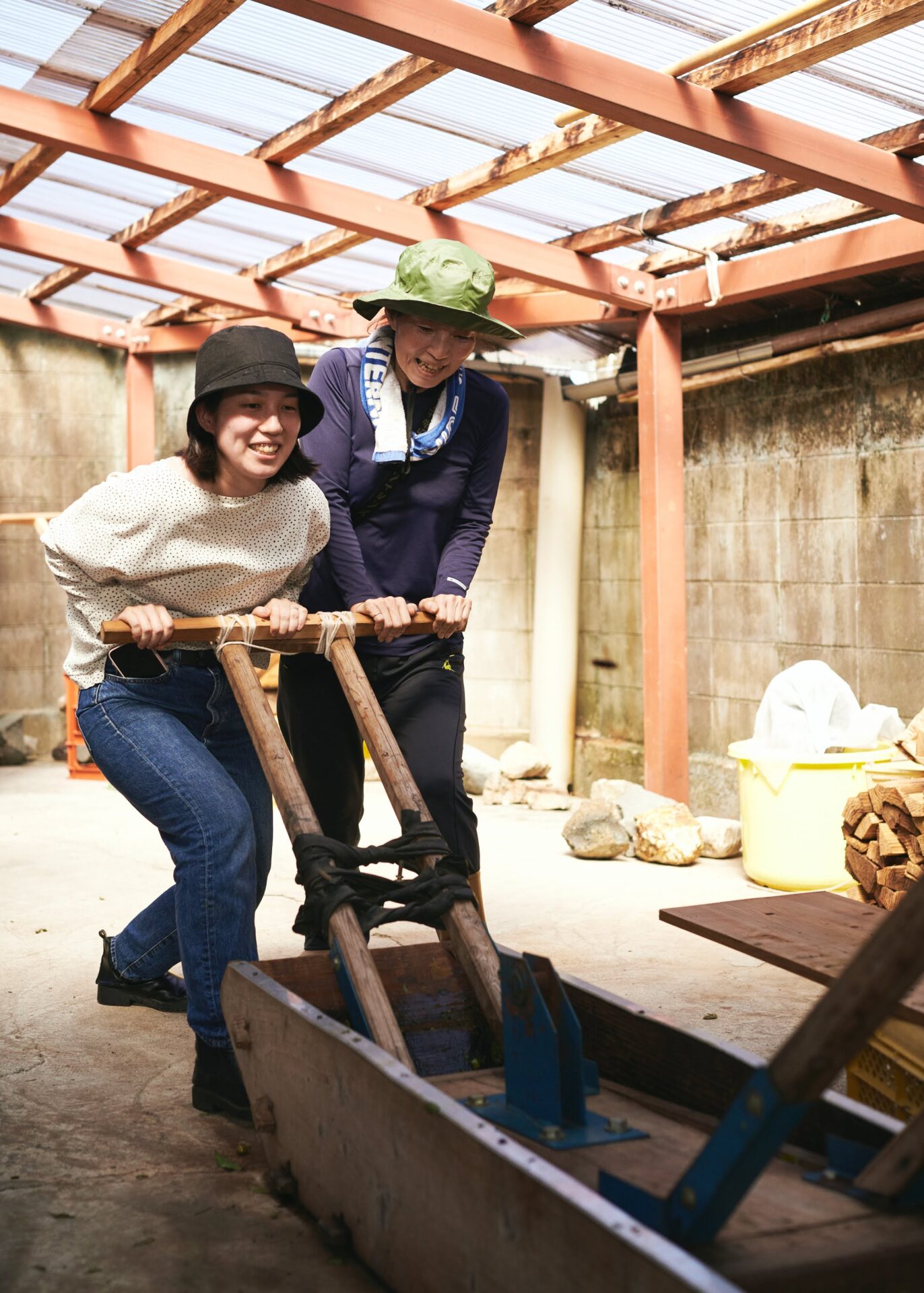
The tea leaves that have been rubbed 200 times have been thoroughly cut, making them softer and very clearly different from the state it was in before.
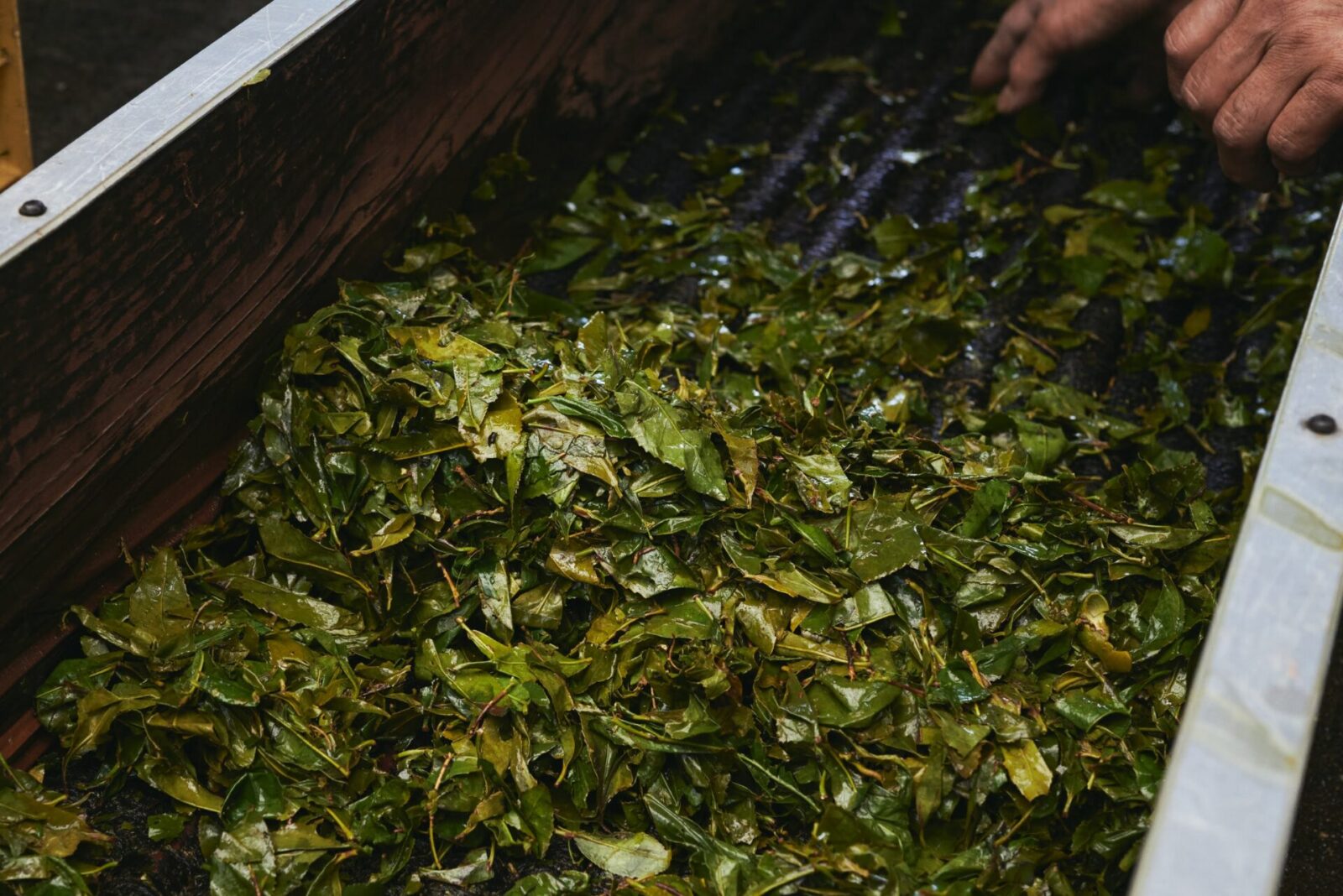
The tea leaves, which are still hot, are then put in the barrel and pressed down with a pestle to remove excess air.
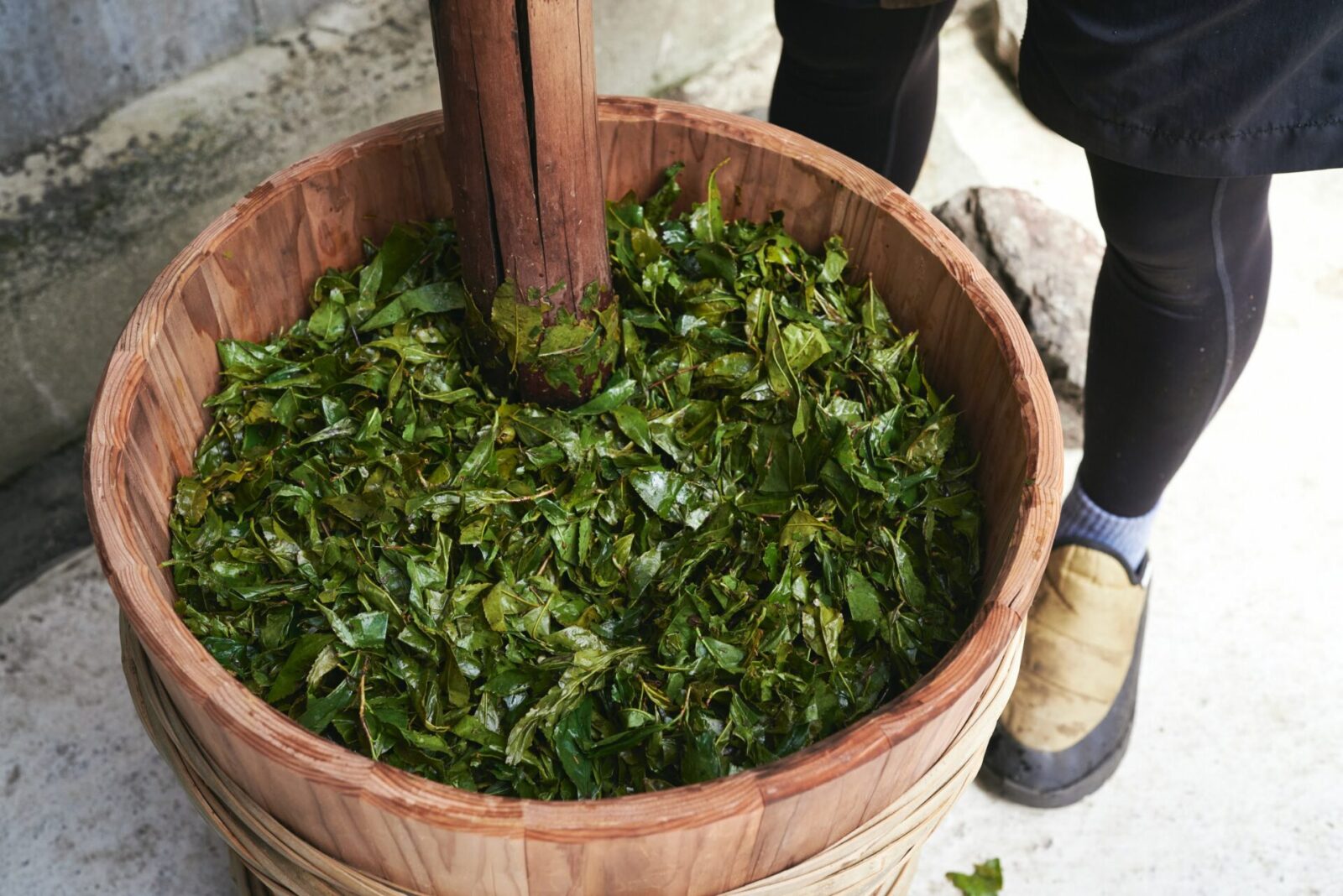
The team members took turns participating in the steps 2 to 5 (boiling, rubbing, soaking) until all of the leaves had undergone the process.
One may get the impression that doing all these steps was simply hard and difficult work, but that is not so.
Of course, it was physically hard work, but with the support of Mima, Takagi and the other staff members, the work was fun and filled with positive energy thanks to their kind and welcoming presence.
Thanks to them, our team was able to enjoy the process from start to finish. Although it was physically tiring, the positive environment lifted our spirits.
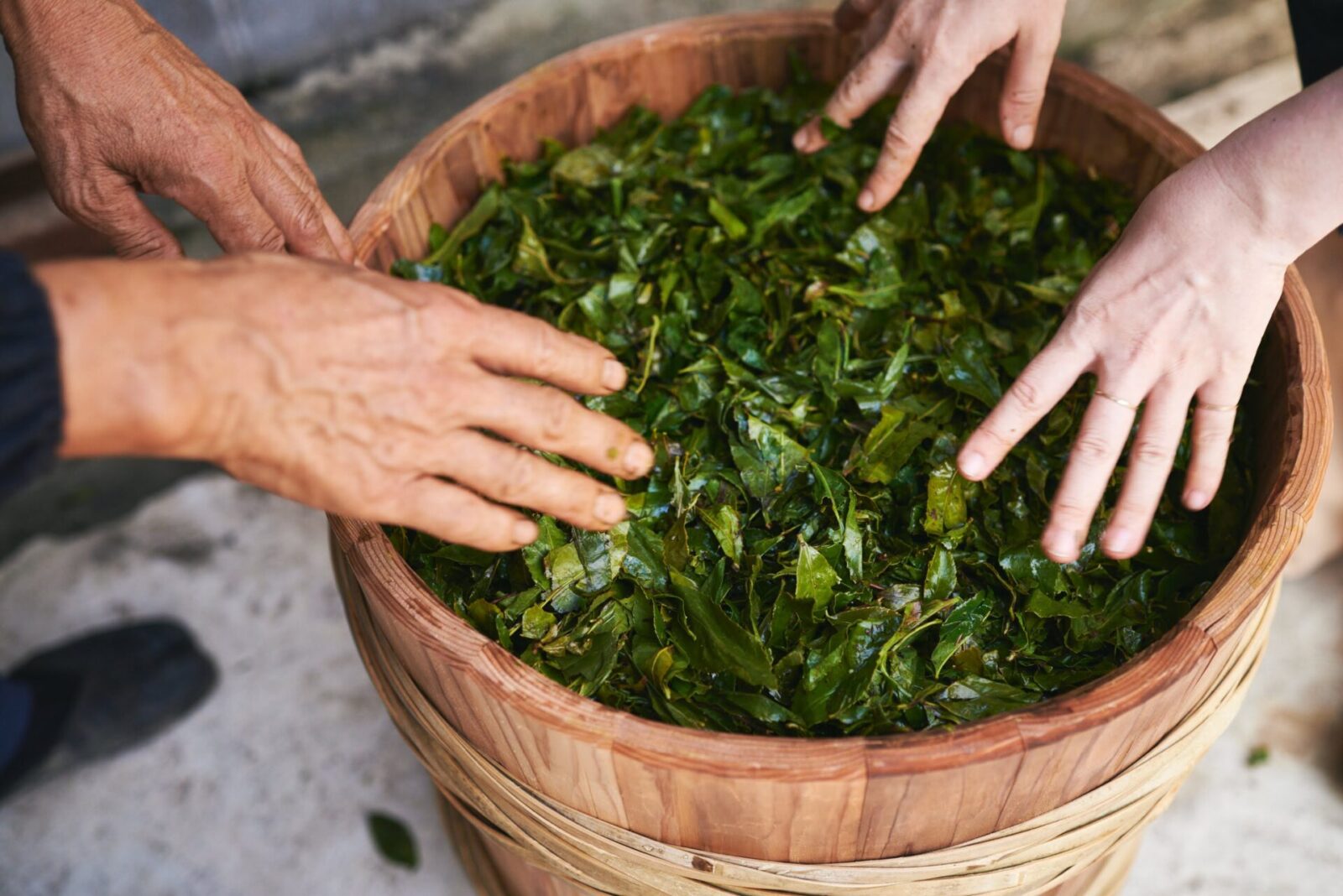
Step 5: Soaking and fermenting
Finally, we approached the final step of the process for the day. After filling the barrel to a point where it is slightly overflowing, Takagi says, “Now we must add a bit of good luck.”
As we watched in wonder of what he meant, he brought over a very very large “basho (Japanese banana leaf).” It is said that the basho has disinfectant properties and the leaf is cut to fit the shape of the barrel and placed on top of the leaves.
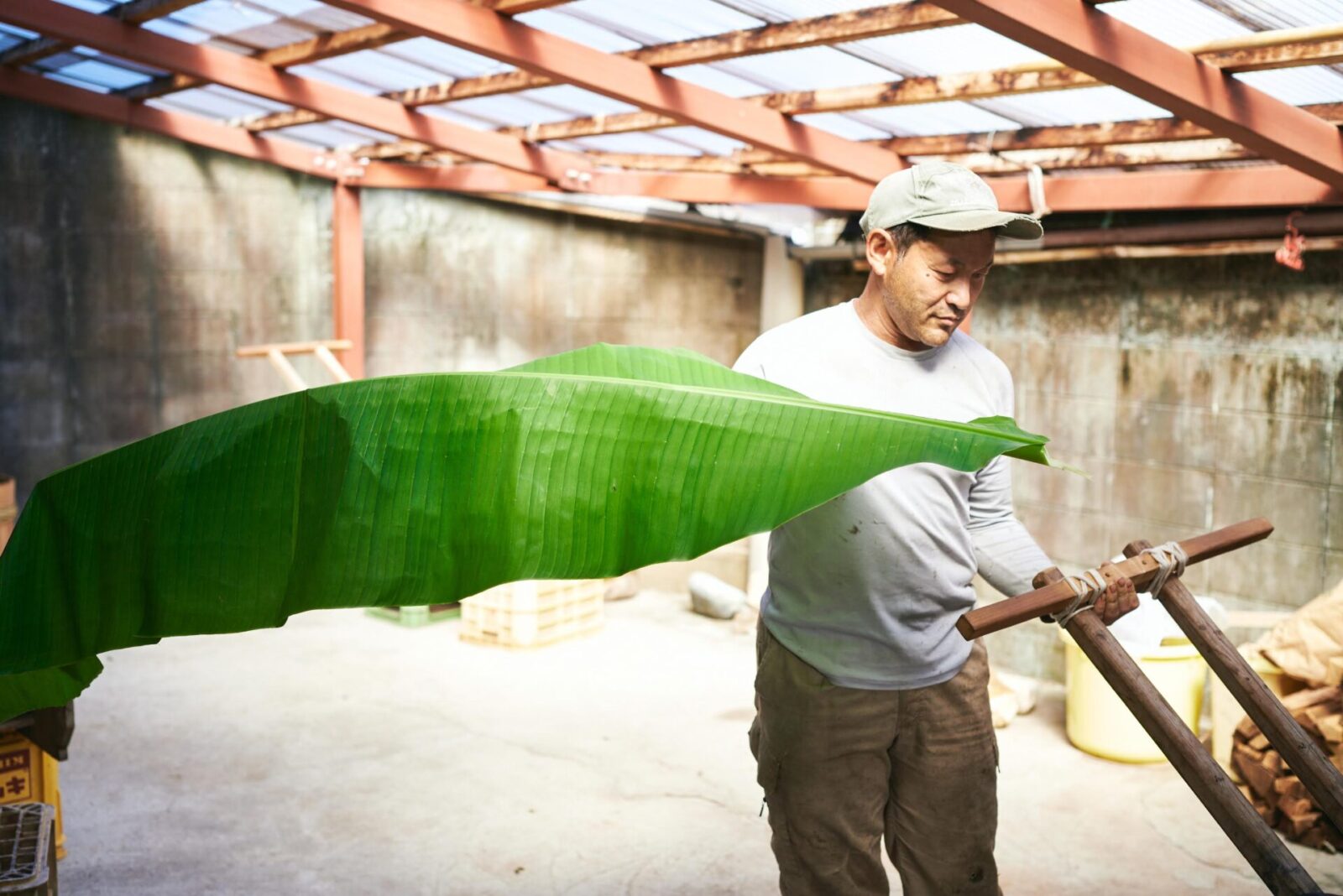
Takagi says, “It’s important to pray for a good result while we lay these down.”
The DIG THE TEA Experiments team all lined up in a row to pray while we lay the bansho leaves on top of our tea leaves. The process was almost like a religious ritual.
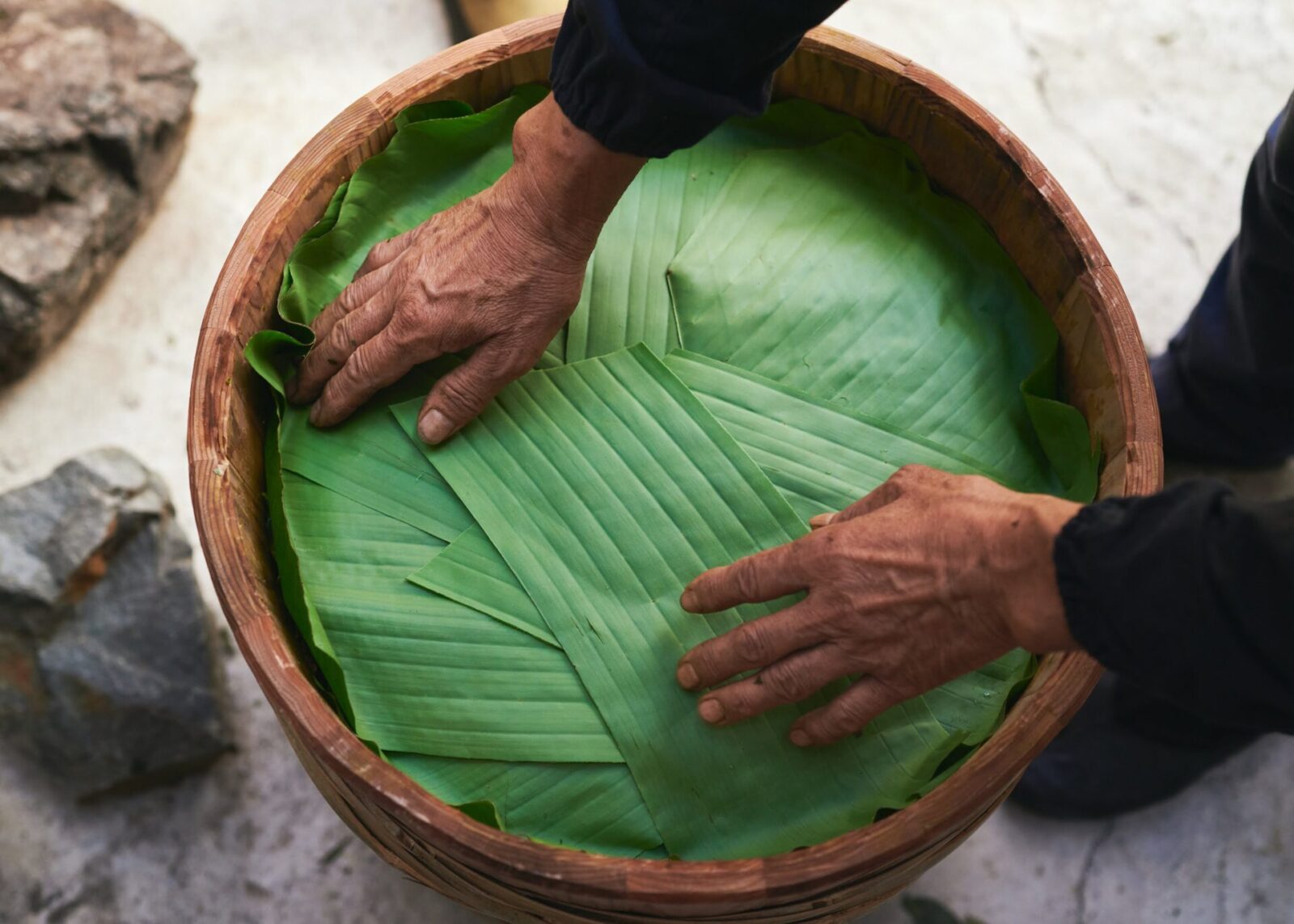
Next, a cloth soaked in the chajiru is tightly wrung out, twisted and stuffed along the outer edges of the inside of the barrel on top of the basho leaves. This step is important to prevent unnecessary bacteria from entering the barrel.
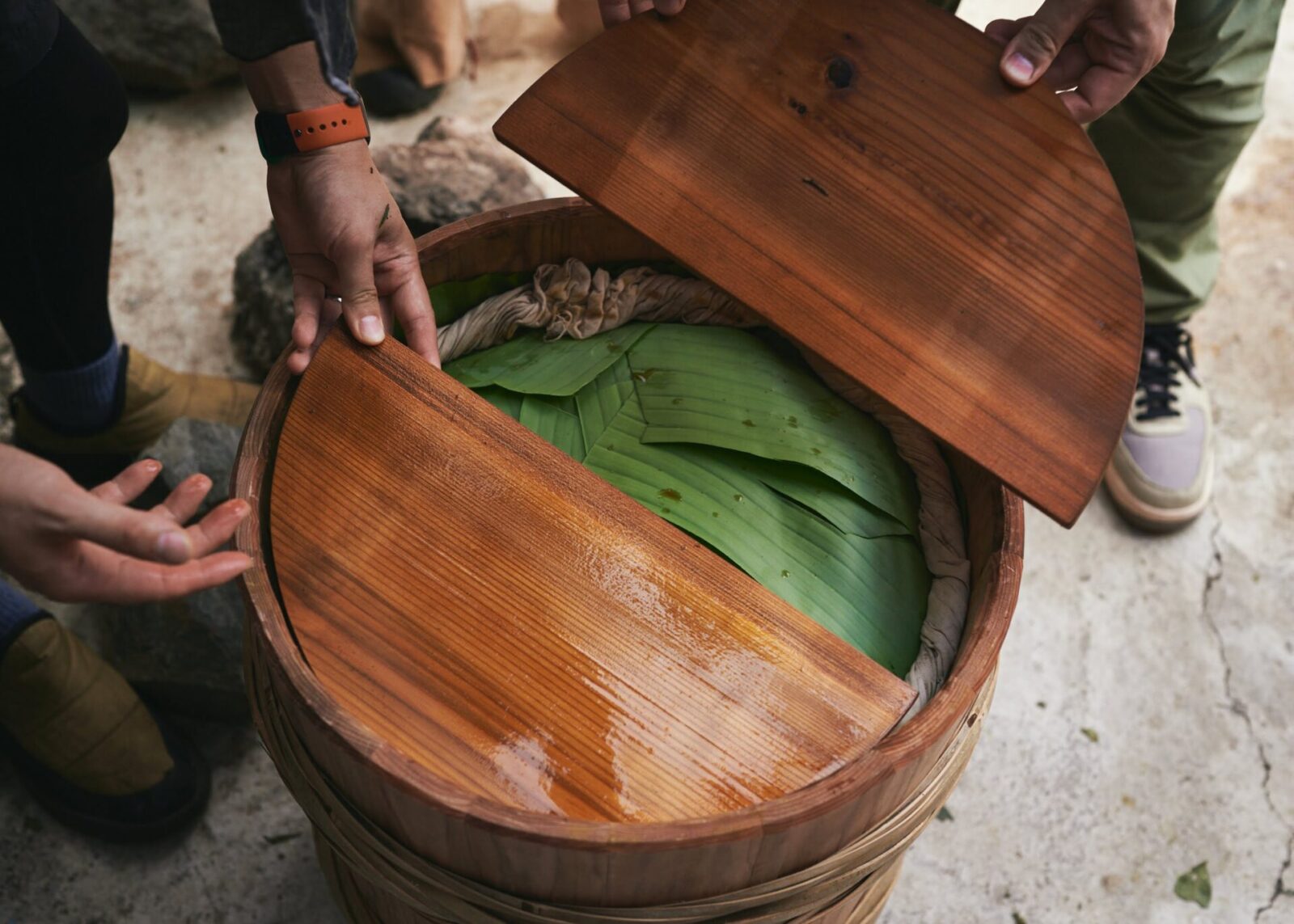
Next, the barrel is covered with a wooden lid and a rock that is slightly heavier than the tea leaves inside is placed on top.
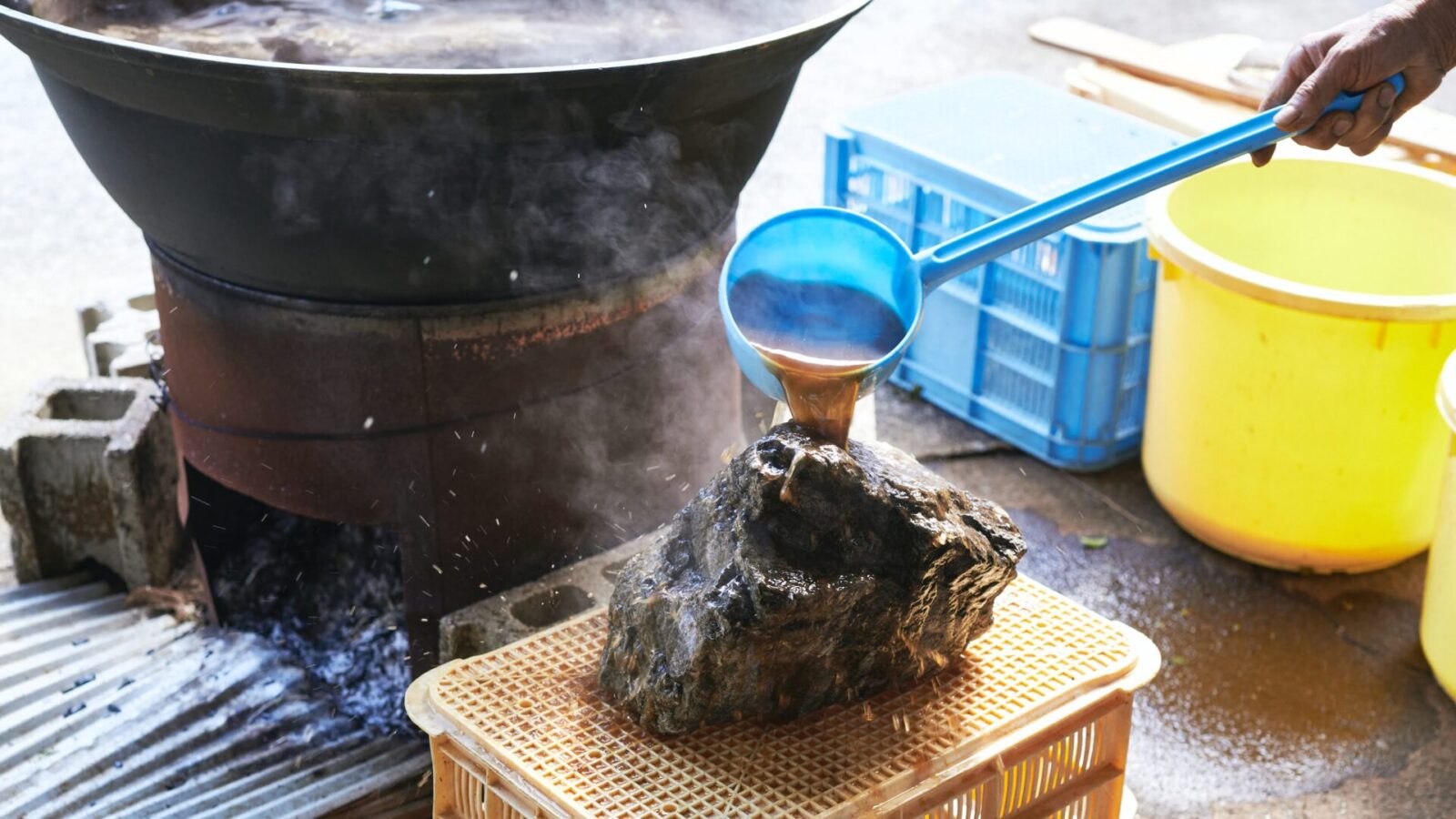
As the final step, the chajiru, which is cooled to about body temperature, is poured in the barrel so none of the tea leaves are exposed to air. The tea leaves will be left in the barrel for about one month to ferment.
This was the end of our day’s work.
When the barrel filled with our Awabancha tea was complete, we all clapped with joy and were filled with a great sense of accomplishment.

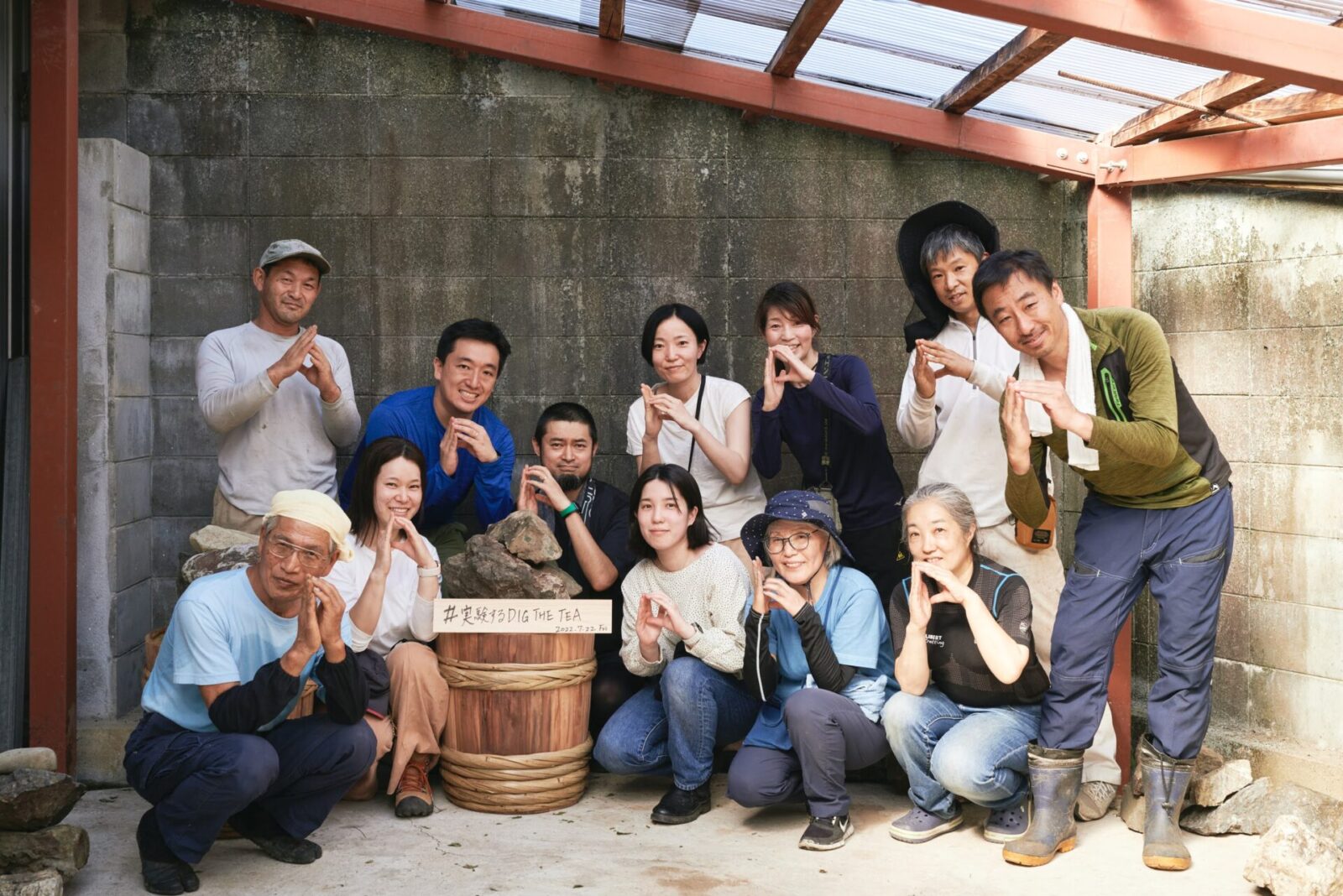
A new hope for Awabancha tea
Our day started at 8 a.m. and we finished all the steps past 4 p.m. Although the process kept us very busy, the time was intense and fulfilling.
We had been told that making Awabancha tea is five times harder than what we can imagine, and we found that to be very true. At the same time, we found that it was ten times more fun than we could have ever imagined.
Through experiencing the process of making Awabancha tea, we developed a deeper appreciation for it and our love for Awabancha tea grew even deeper. Our experience of interacting with the warm people of Kamikatsu Town and its rich natural environment also played a big part in enriching our experience.

The barrel owner program just started last year. They have had many participants, from people working on Tokushima Prefecture’s local magazines, restaurant owners, hotel business owners and more. Guests staying at local hostels have come to experience the making of Awabancha tea, and local cafes have added Awabancha tea and paired sweets to their menu. People of various industries are working together to promote the local specialty.
One owner of a kimono shop shared, “Last year we packaged and sold the Awabancha tea we made ourselves and our customers loved it. We sold out very quickly. This year we invited our customers to join us in making the Awabancha tea as well.”
We asked Takagi, who came up with the barrel owner program, how he thinks it is going so far.
“Although I am a professional in making tea, I cannot say I am a professional when it comes to promoting the product. The more people learn about Awabancha and the more the word spreads, I believe that the value of Awabancha tea will go up and this will help encourage more farmers to produce it.”

“We are very grateful that the participants of the program have gone on to promote Awabancha tea in ways that we could not imagine ourselves. However, the program has just begun. Although things won’t change overnight, I believe it is important to keep it going.”
Miwa smiled as he shared, “I am glad people are learning about Kamikatsu through Awabancha tea, and as a farmer, it makes me very glad when consumers enjoy the flavor of our product. It makes me even happier that more people are showing interest in making it. Takagi started this program and he is like a savior to our Kamikatsu town.”
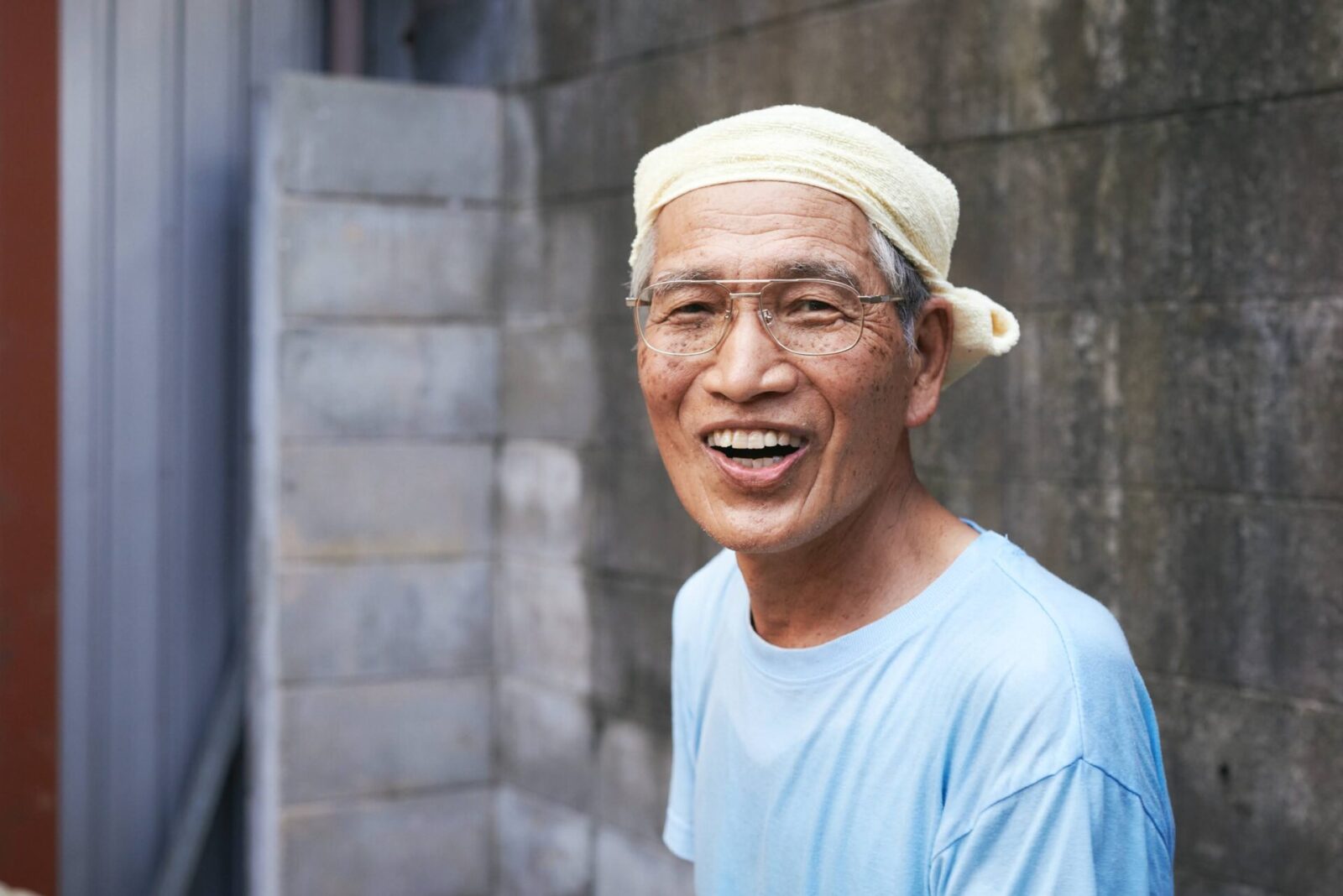
The challenges surrounding Awabancha tea will not be resolved overnight. However, the waves of change are clearly growing.
After participating in this program, the DIG THE TEA team also hopes to find ways to help preserve Awabancha tea for future generations. Our “DIG THE TEA Experiments” on Awabancha tea has just begun.
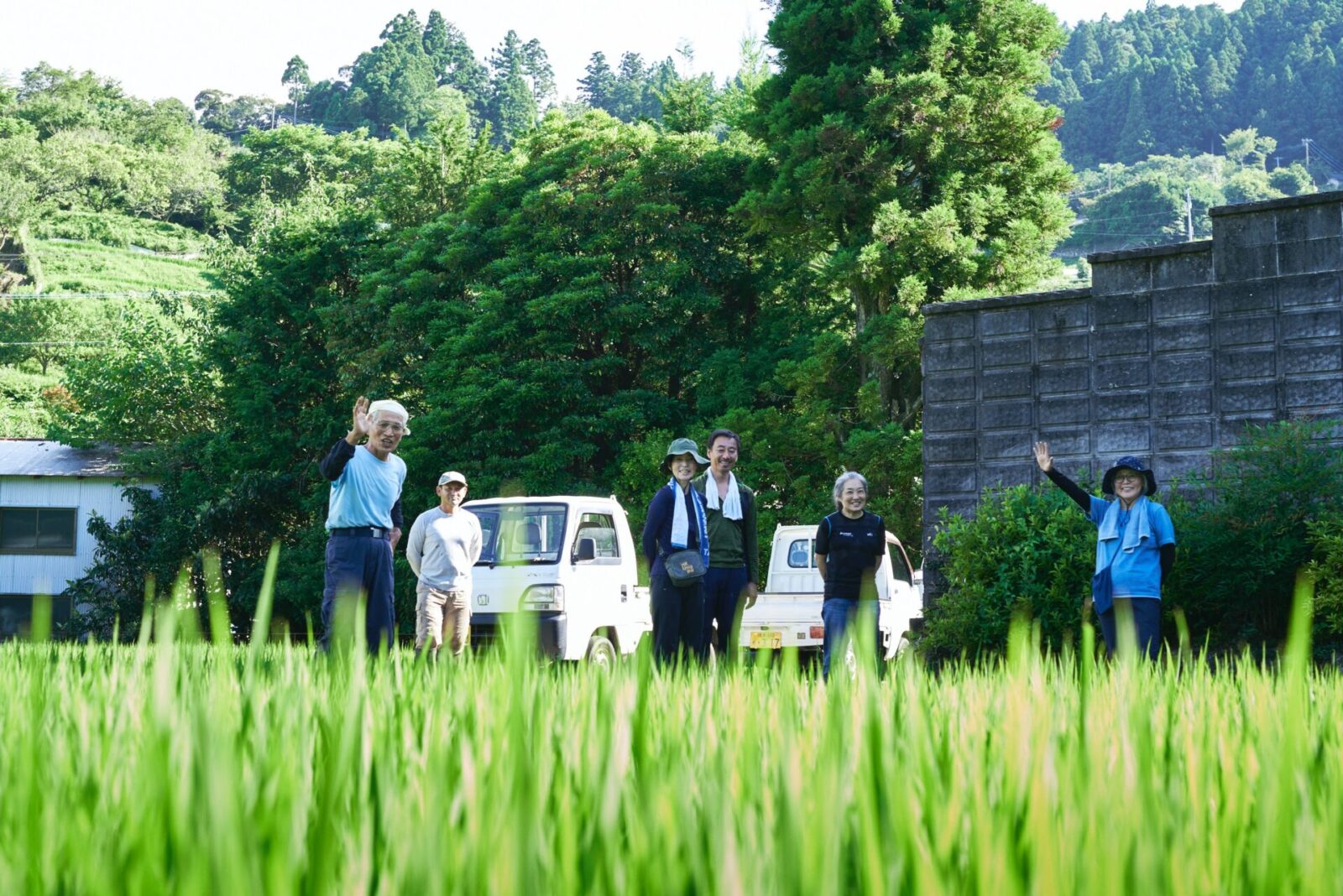
Photo: Umihiko Eto
Lives in Tokyo, Japan. Became independent after working as an editor for online media sites “MYLOHAS” and “greenz.jp” and magazine “sotokoto”. Edits and writes for magazines, online media, books, and other media outlets, as well as corporate websites, on themes such as sustainable manufacturing, community development, and working styles. Also acts as director and buyer for the online store and media “ichijitu” which offers everyday products and tools that assist in everyday life.
Editor. Born and raised in Kagoshima, the birthplace of Japanese tea. Worked for Impress, Inc. and Huffington Post Japan and has been involved in the launch and management of media after becoming independent. Does editing, writing, and content planning/production.
